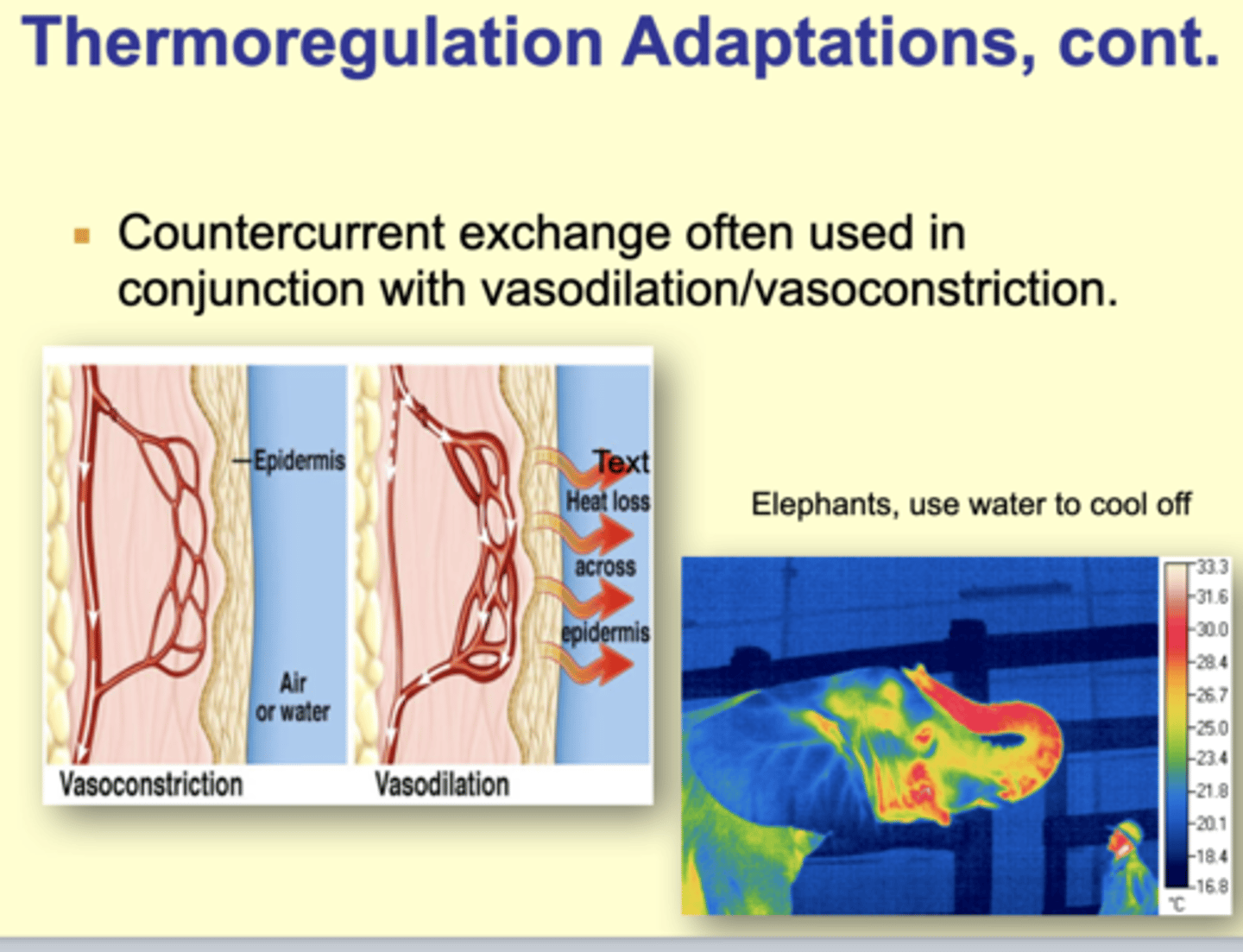Chapter 7b: Animal Adaptations
1/66
There's no tags or description
Looks like no tags are added yet.
Name | Mastery | Learn | Test | Matching | Spaced |
|---|
No study sessions yet.
67 Terms
Question within the chapter?
What influences heat exchange b/w an animal and its environment?
How do animals thermoregulate?
What are some adaptations for thermoregulation?
Thermal conductivity
Consider a simple thermal model of an animal's temperature:
- The body core is separated from the surface by layers of muscle and fat-insulation (L) that affects the animal's __________________.
* Rate of heat exchange with environment is also influenced by boundary layer, which can be changed die to feathers hair, etc,
(DEF: the rate at which a substance transfers heat)
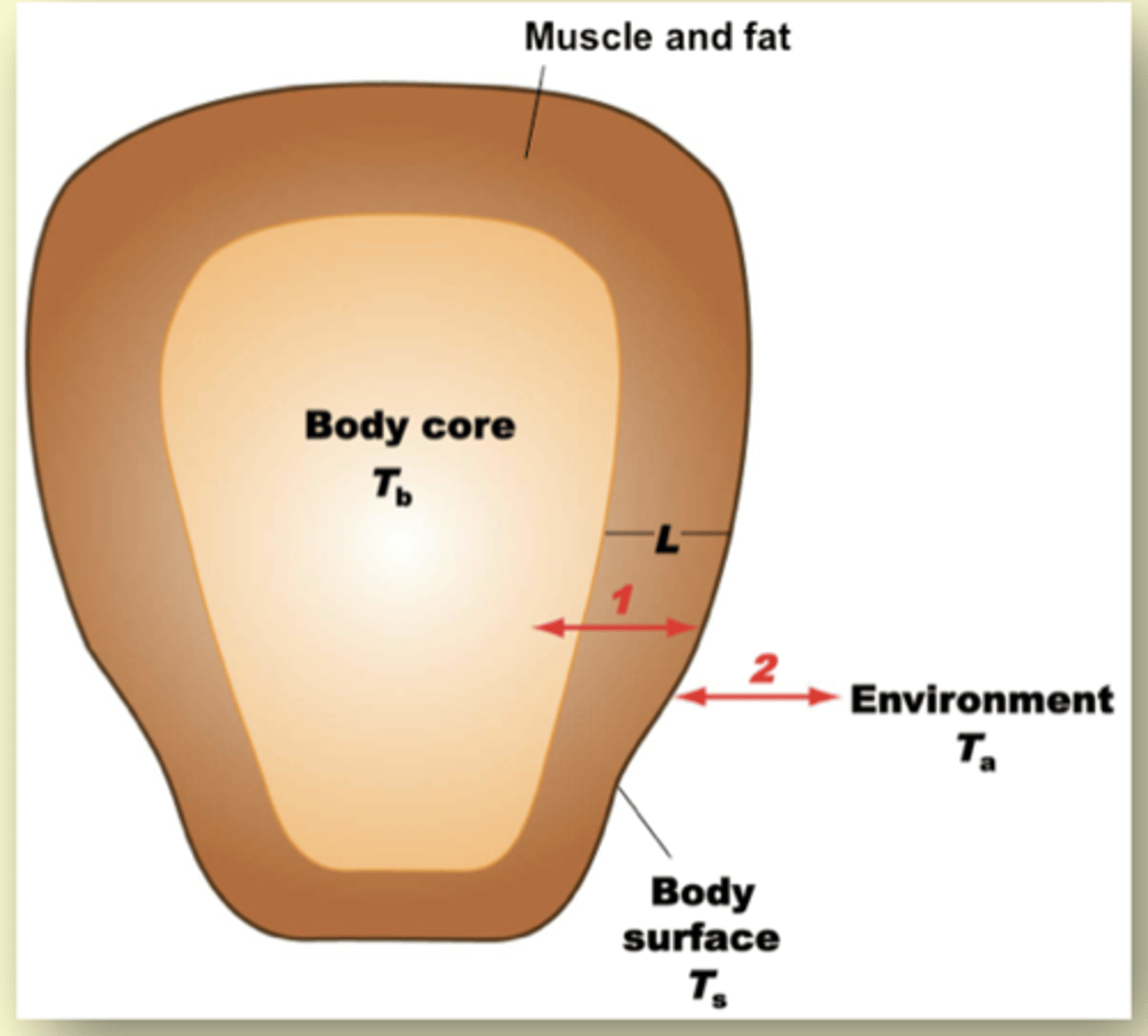
How does an animal contain its core temperature?
To maintain its ______________, an animal balances gains and losses of heat to the external environment through
- Changes in metabolic rate
- Heat exchange
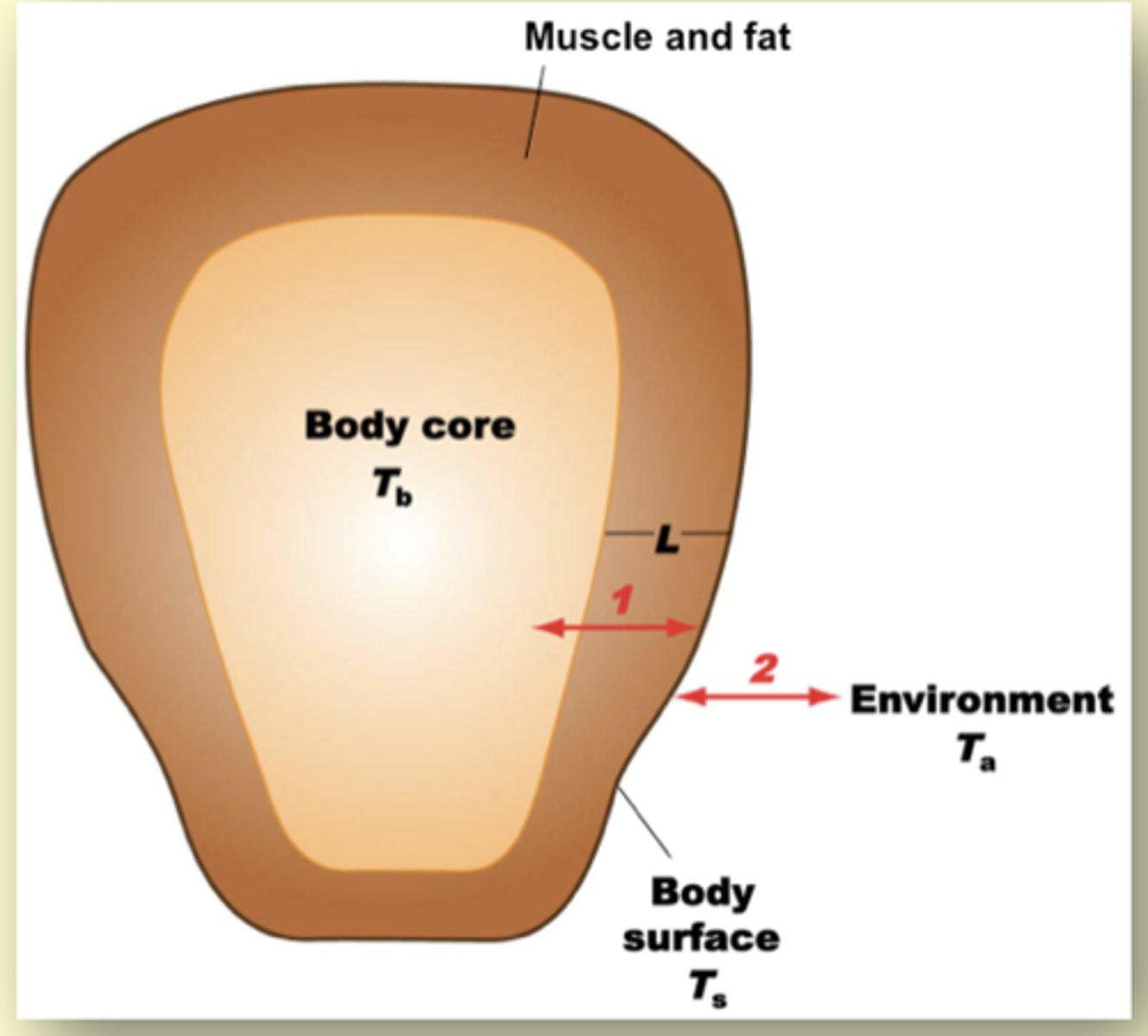
Why is heat lost via metabolism ? (maintain core temperatures)
Conversion of potential energy to kinetic energy from cellular respiration to cellular work is not perfectly efficient... most energy lost as heat
- 2nd law of thermodynamics
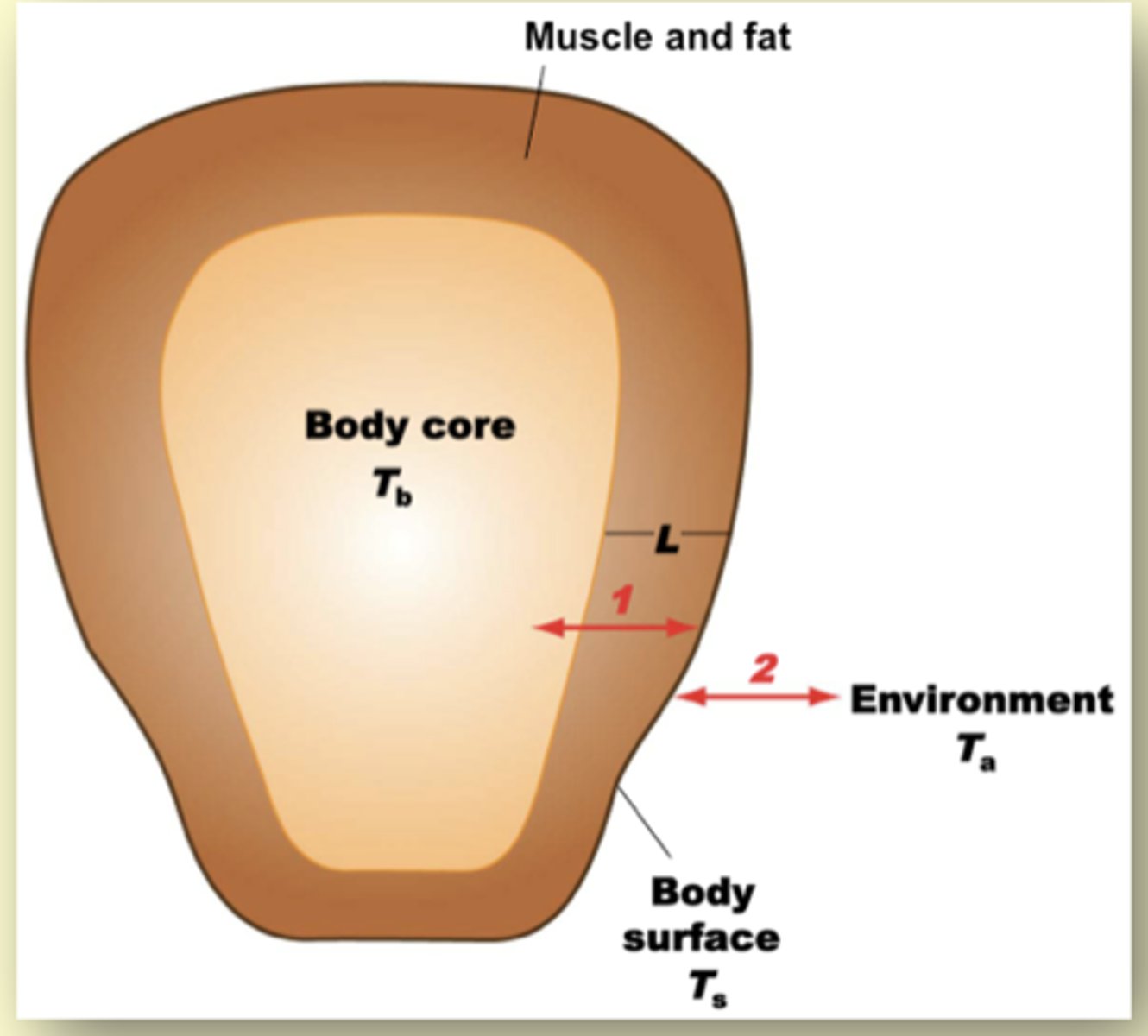
Heat exchange (maintain core temperatures)
Core changes heat with the surface through conduction and convection
- influenced by the thickness of L and blood flow
---------
Surface exchange heat with the environment through
- Conduction, Convection, Radiation, Evaporation
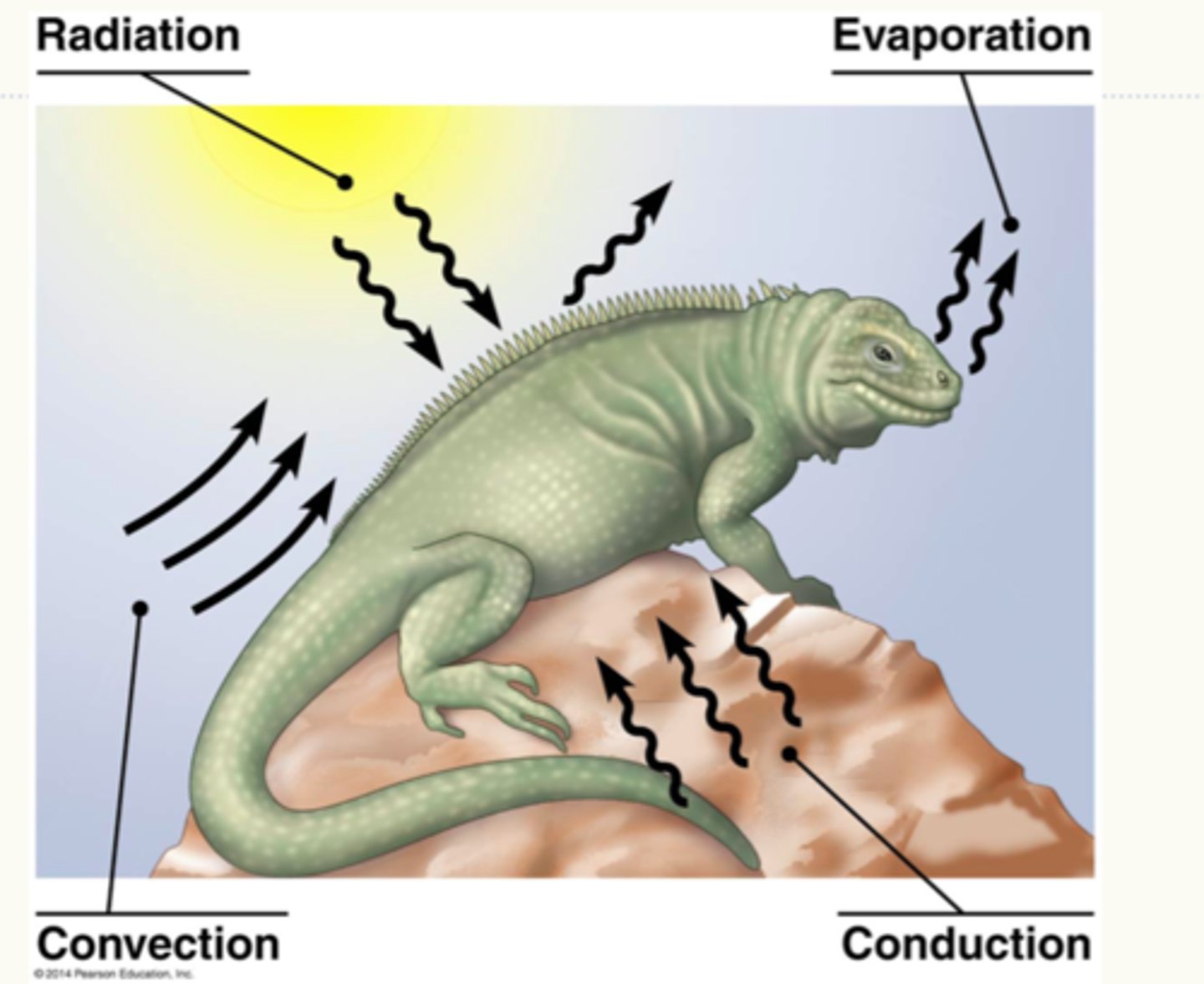
Terrestrial animals (changes to thermal environment)
Have much larger changes to their thermal environment than aquatic animals.
---
WHY? -- Air has a lower specific heat and absorbs less solar radiation
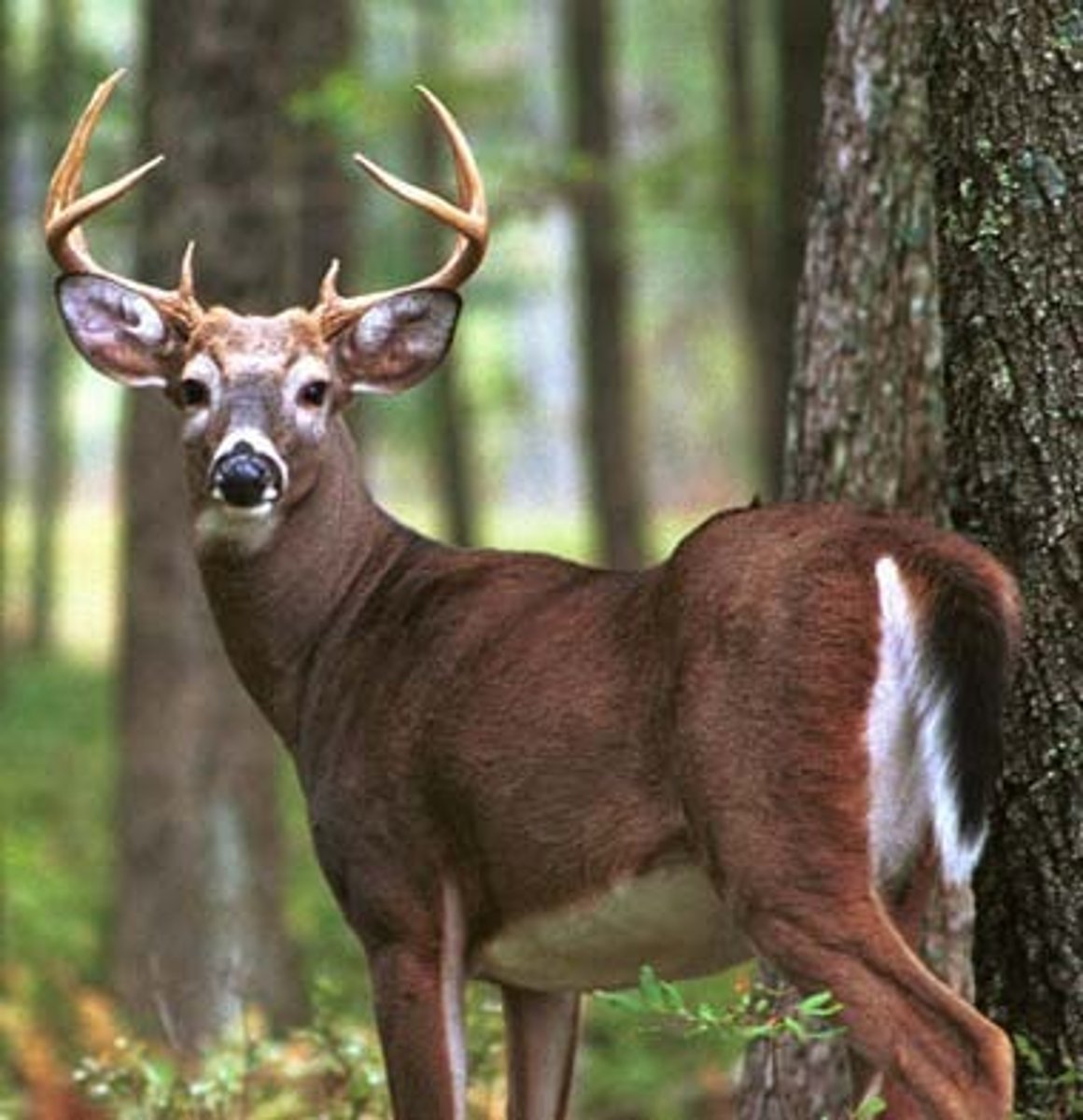
Air has a lower specific heat and absorbs less solar radiation (Terrestrial animals-much larger changes)
- incoming solar radiation (day) can rapidly increase heat
- loss of radiant heat (night) can rapidly decrease heat
Aquatic animals (changes to thermal environment)
generally have a lower tolerance for temperature changes.
---
Hence why we see less change
Ex, Fish, leg bag acclimate before putting fish in tank
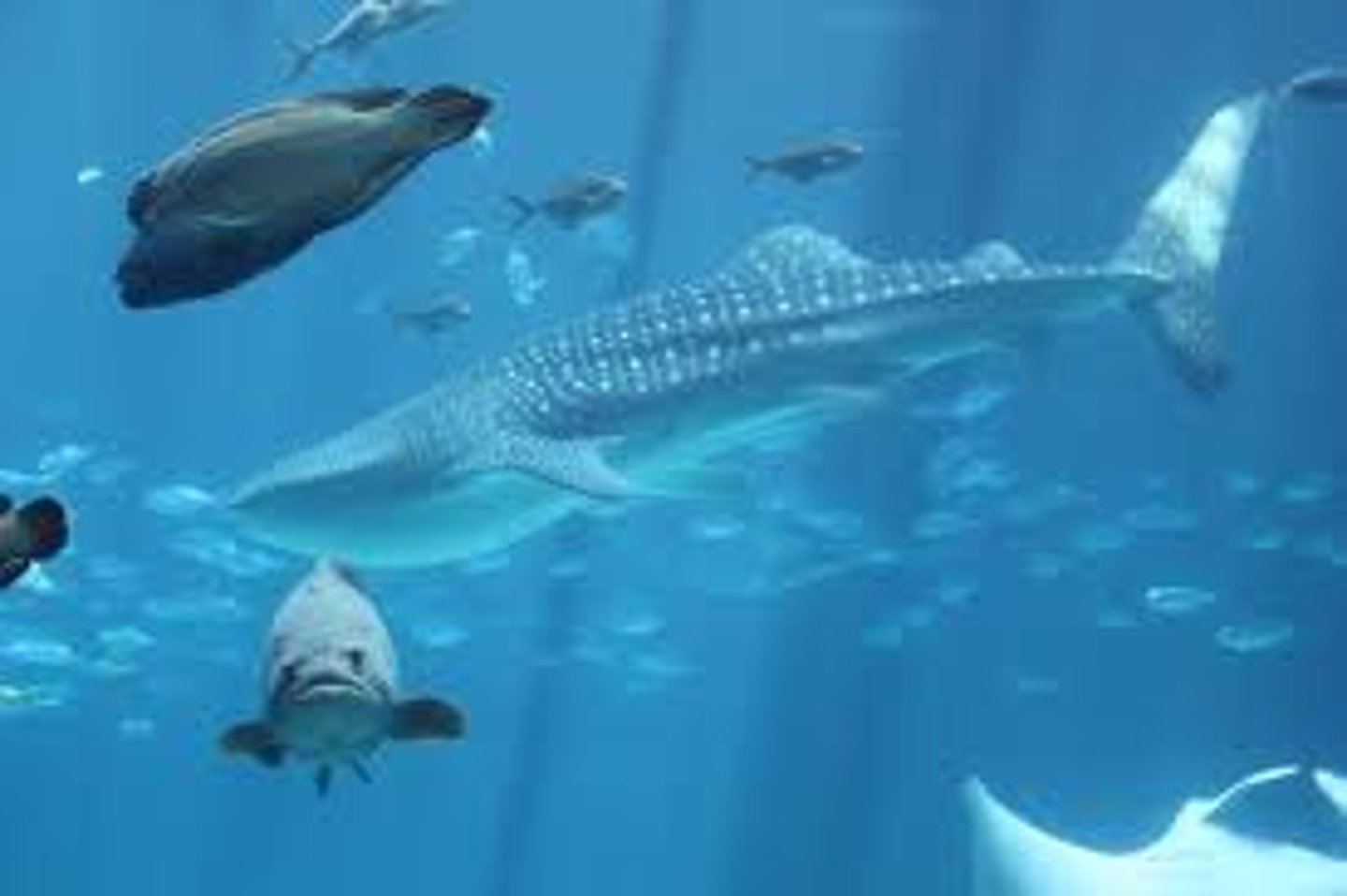
Poikilotherms
animals that have a variable body temperature
(not constant temp)
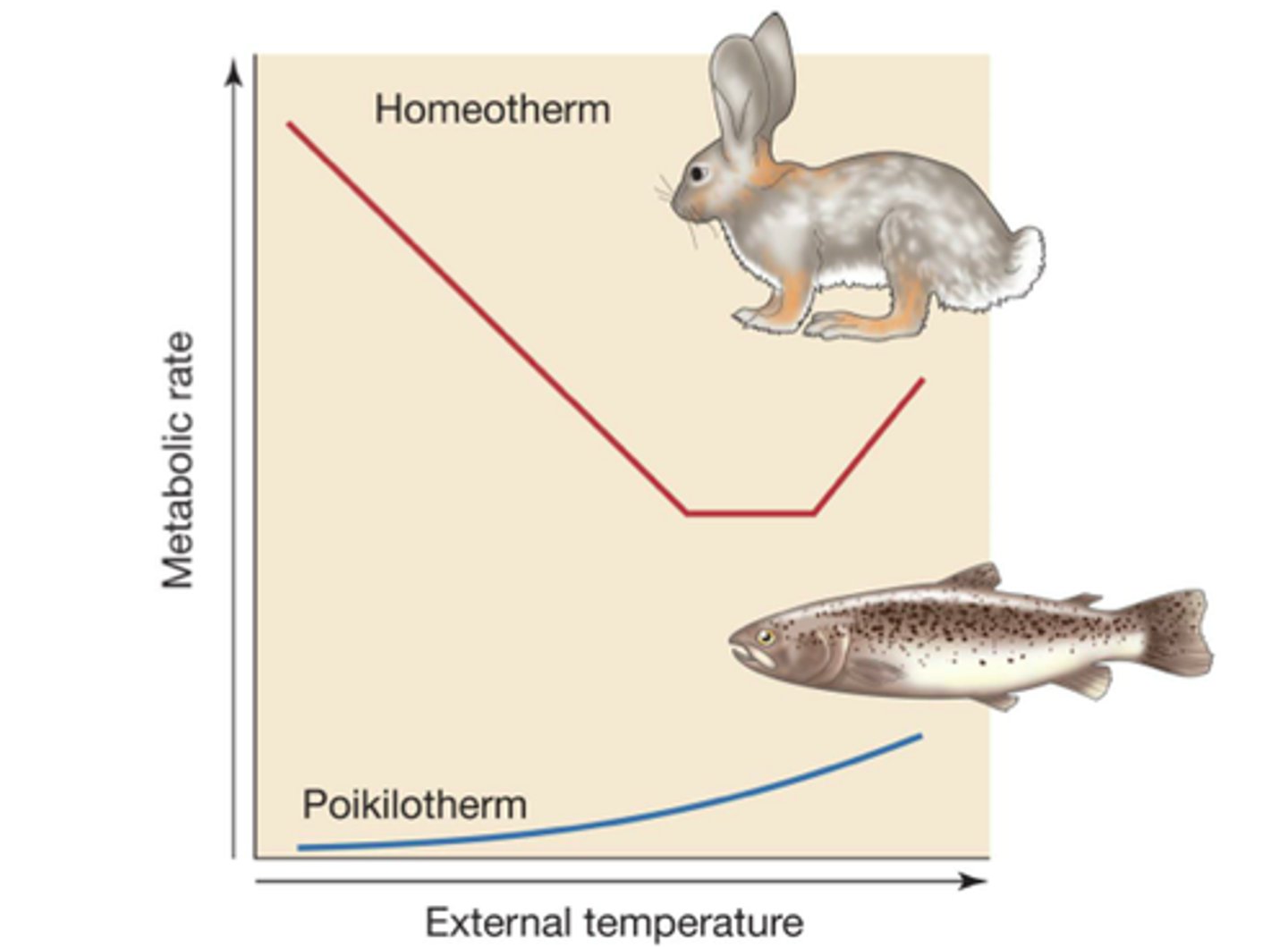
Homeotherms
animals that have a constant, or nearly constant, body temperature
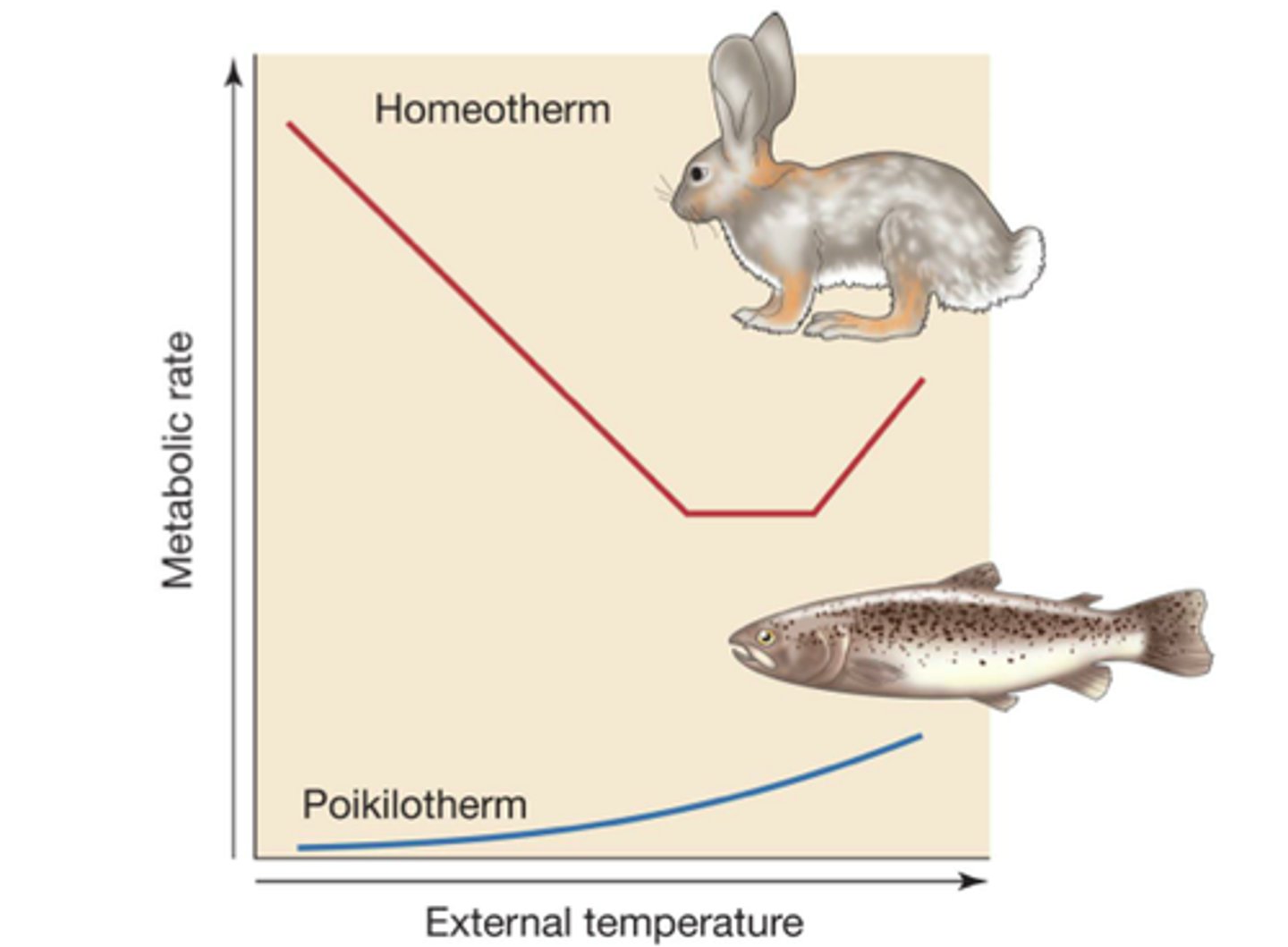
Poikilotherms/ Homeotherms are not synonymous with conformers and regulators..
Only true thermoconformers are animals that live in environments with almost no variation in temperature...
such as the deep ocean (zero change in temperature)
Environmental temperature vary spatially and temporally
Animals regulate body temperature through
- Behavior
- Physiology
- Morphology
** Animals must sense and respond to their thermal environment
Ectothermy
--process of maintaining body temperature through the exchange of thermal energy with the surrounding environment.
- animals that do this are ectotherms (>99.9% of animals are ectothermic)
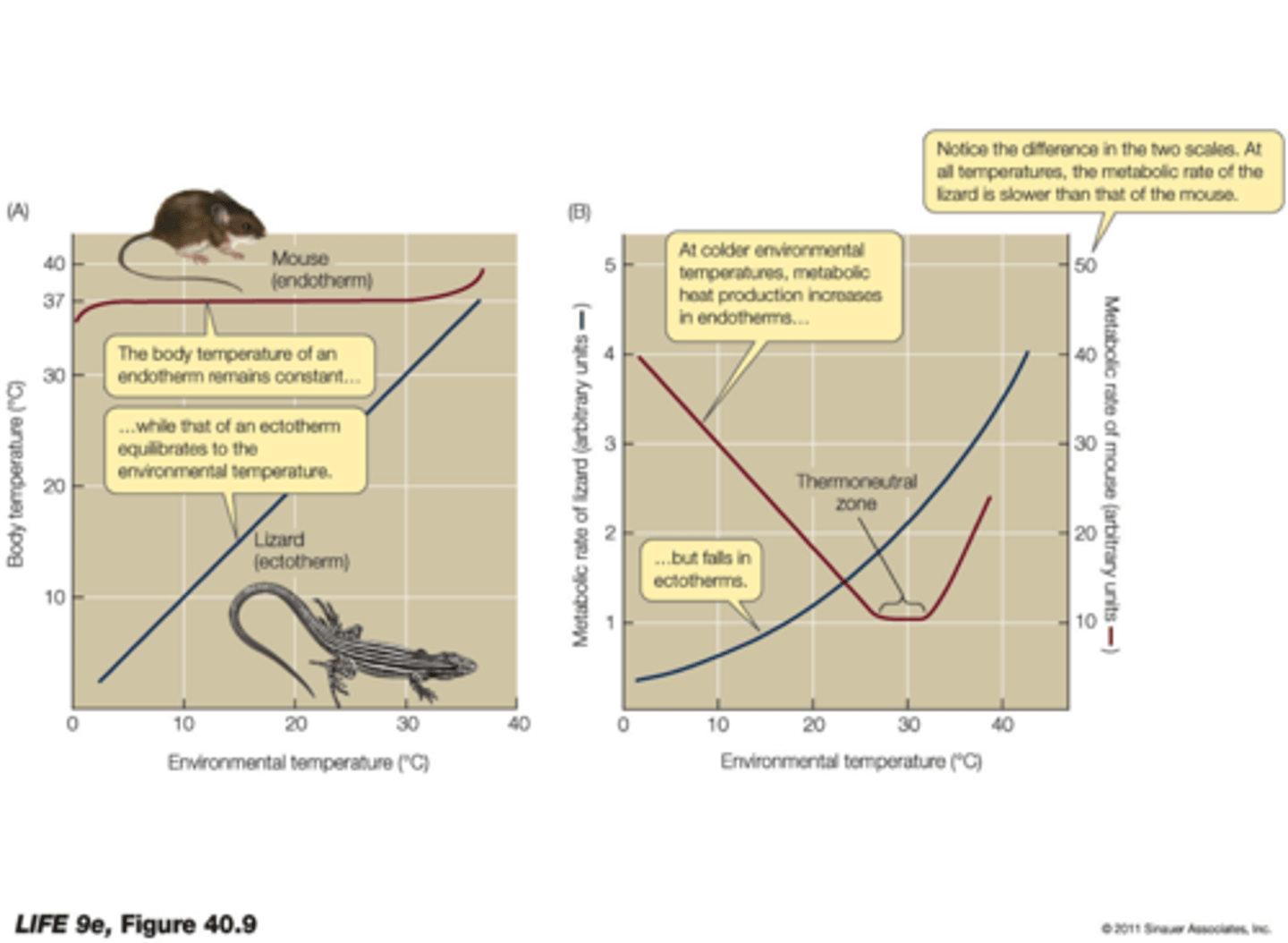
Endothermy
-- process of maintaining body temperature through internally generated metabolic heat
- animals that do this are endotherms
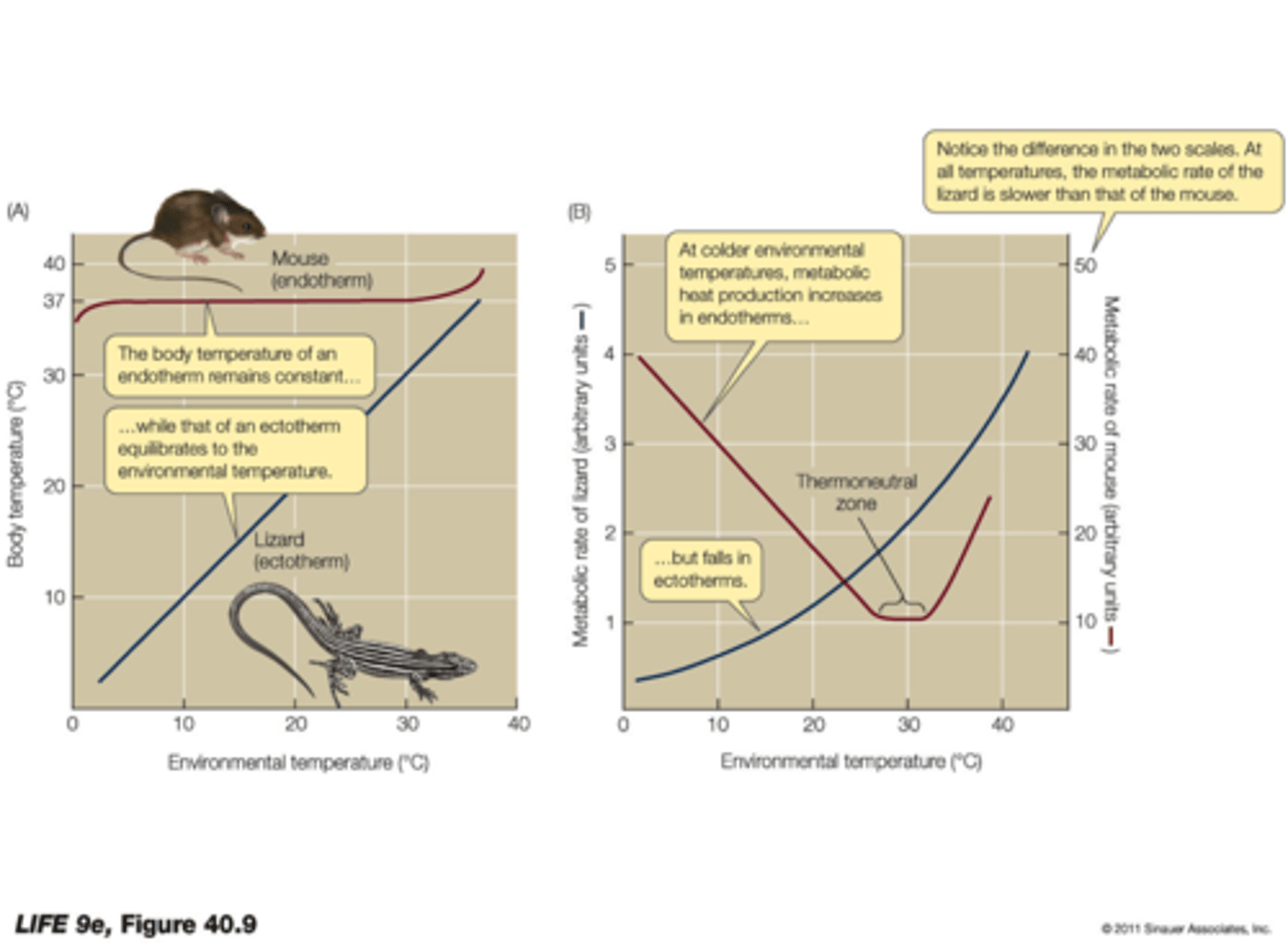
**Performance measures that vary as a function of body temperature in poikilotherms include:
- locomotion
- growth
- development
- fecundity
- survivorship
** Pretty big advantage to being at a particular temperature in terms of ______________.
locomotion
----
Thermal performance cure
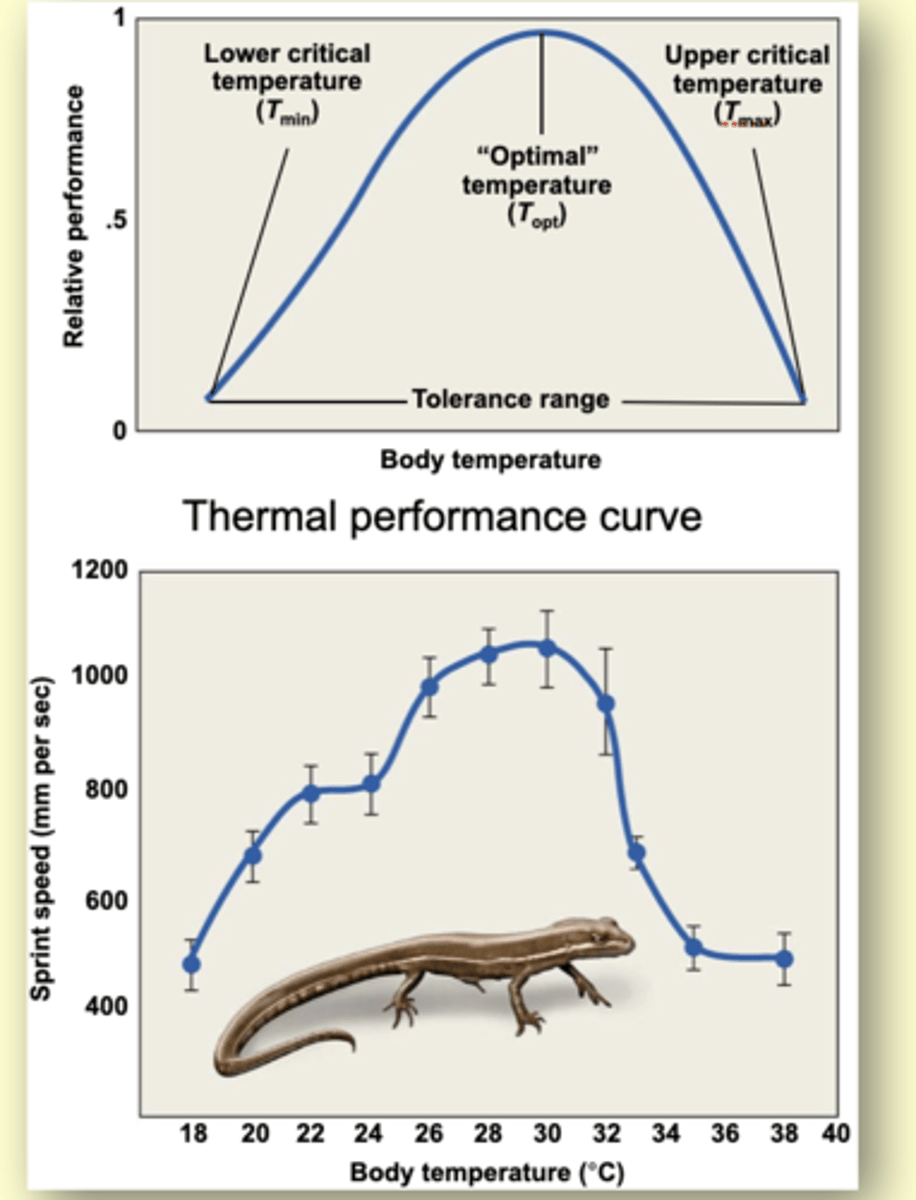
* Metrics of thermal performance curves can be compared.
What is this graph showing us?
- T(max) is related to habitat temperature within a genus of porcelain crabs
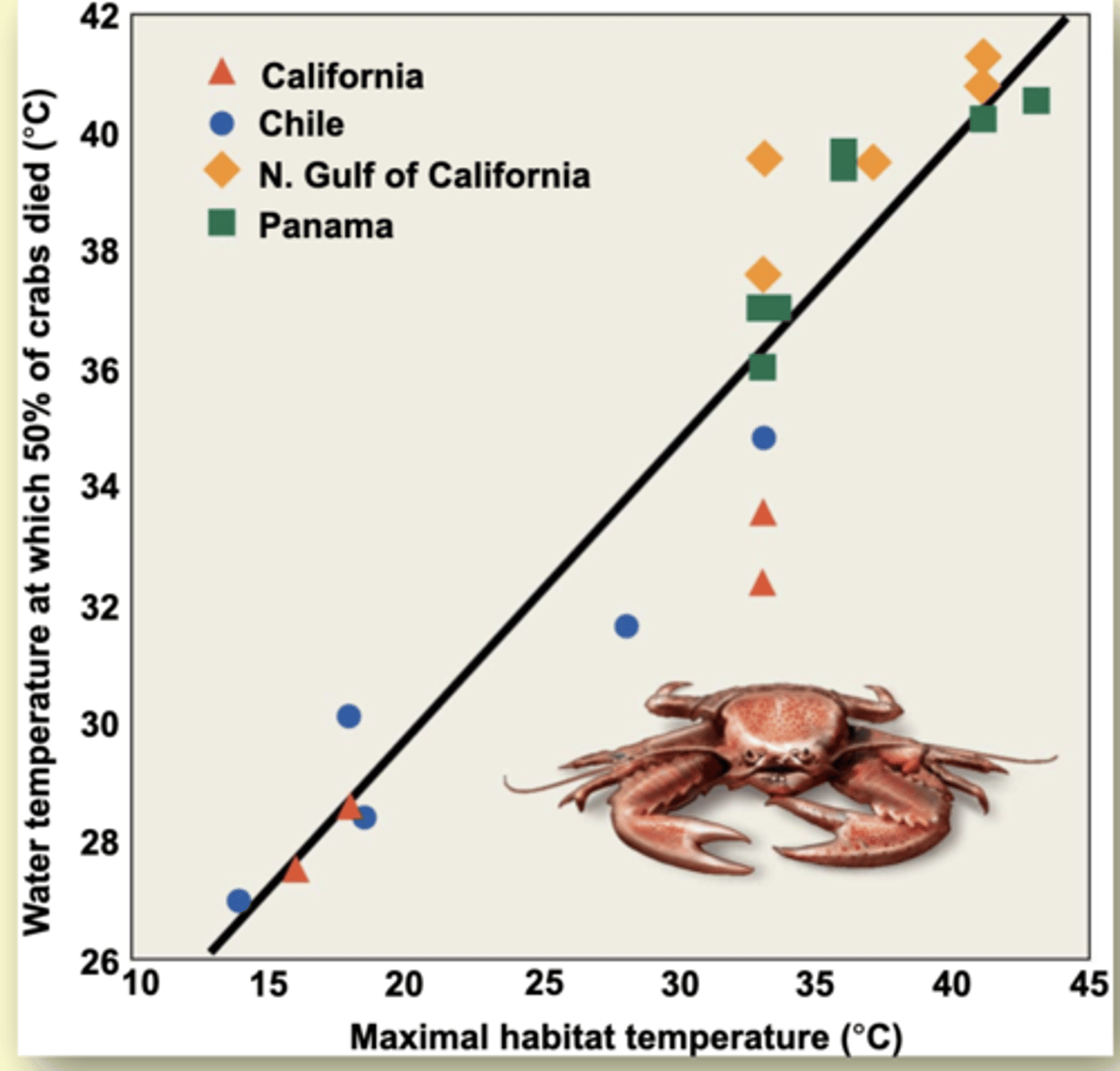
**Characteristics of poikilotherms include
1. Low metabolic rate
2. High thermal conductivity
"What does this mean about insulating properties of L (fat and muscle) in the body?"
3. Aerobic respiration during normal activity
4. Under increased activity and stress, most energy is produced anaerobically
-depletes stored energy
- lactic acid accumulates in muscles
"What does this mean about insulating properties of L (fat and muscle) in the body?" --(Characteristics of poikilotherms include)
Minimal insulation typically
---
2. High thermal conductivity
**Poikilotherms use mainly ___________.
Behavioral thermoregulation
1) Seeking out appropriate microclimates
- Environmental temperatures allow near optimal body temperature
* Bask in the sun to warm
* Rest in the shade to cool
---
2) Change conduction between the animal and rocks/soil by
- Raising and lowering the body
- Changing the body shape
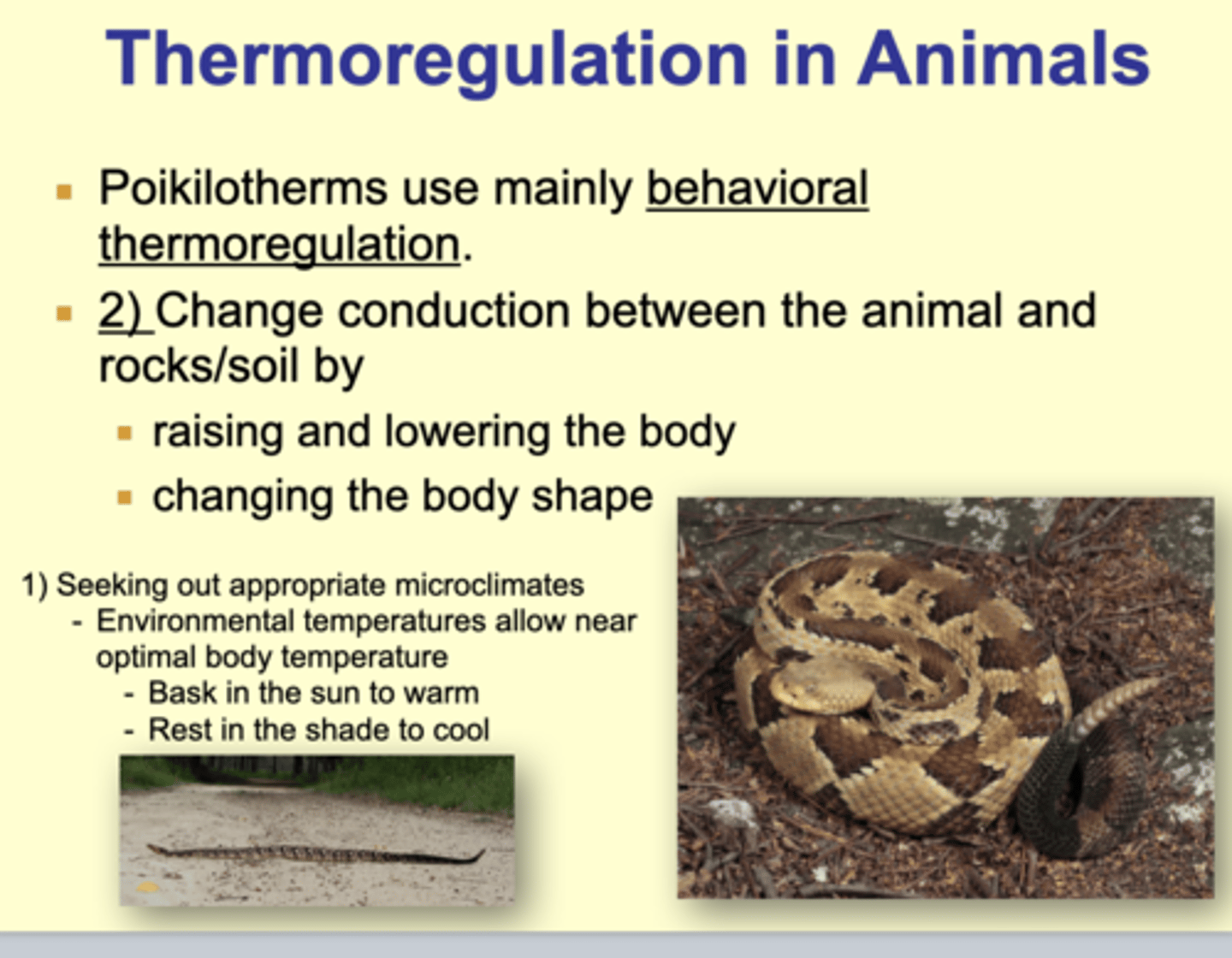
Temperature in free-ranging lizards was significantly different than air temperature (Experiment)
Work from the early-mid 20th century demonstrated that body temperature in free-ranging lizards was significantly different than air temperature.
-------
Example: T(body) was lower and less variable than T(air)
Problem: Researchers didn’t directly observe behavioral thermoregulation AND there were no control.
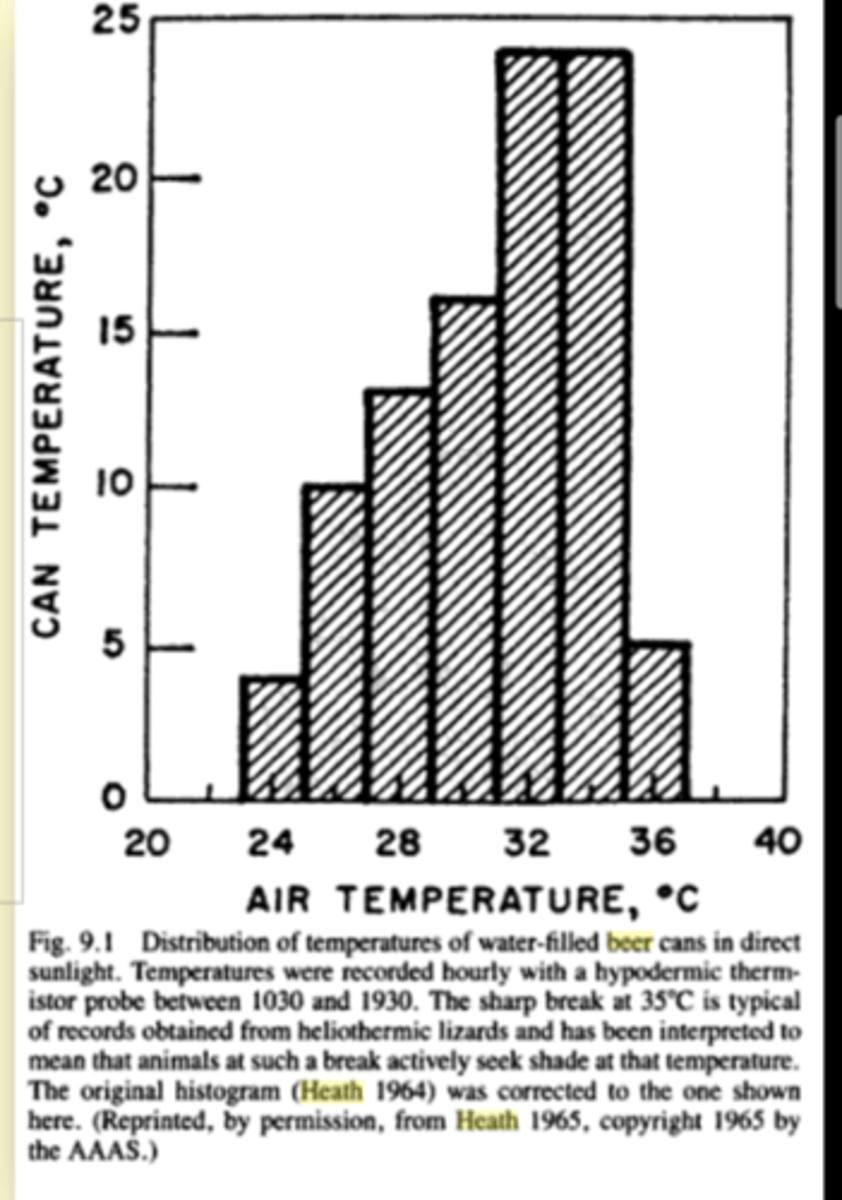
Blouin Demers and Weatherhead...
studied behavioral thermoregulation in black rat snakes.
------
- Individual snakes implanted with temperature-sensitive radio transmitters.
-----
Operative environmental temperature (T"operative")– body temperature when an animal (in this study: snake) occupies a particular environment.
- Estimated range of body temperatures available to snakes in each habitat
- Determined via physical models that matched snake reflectance and conductance
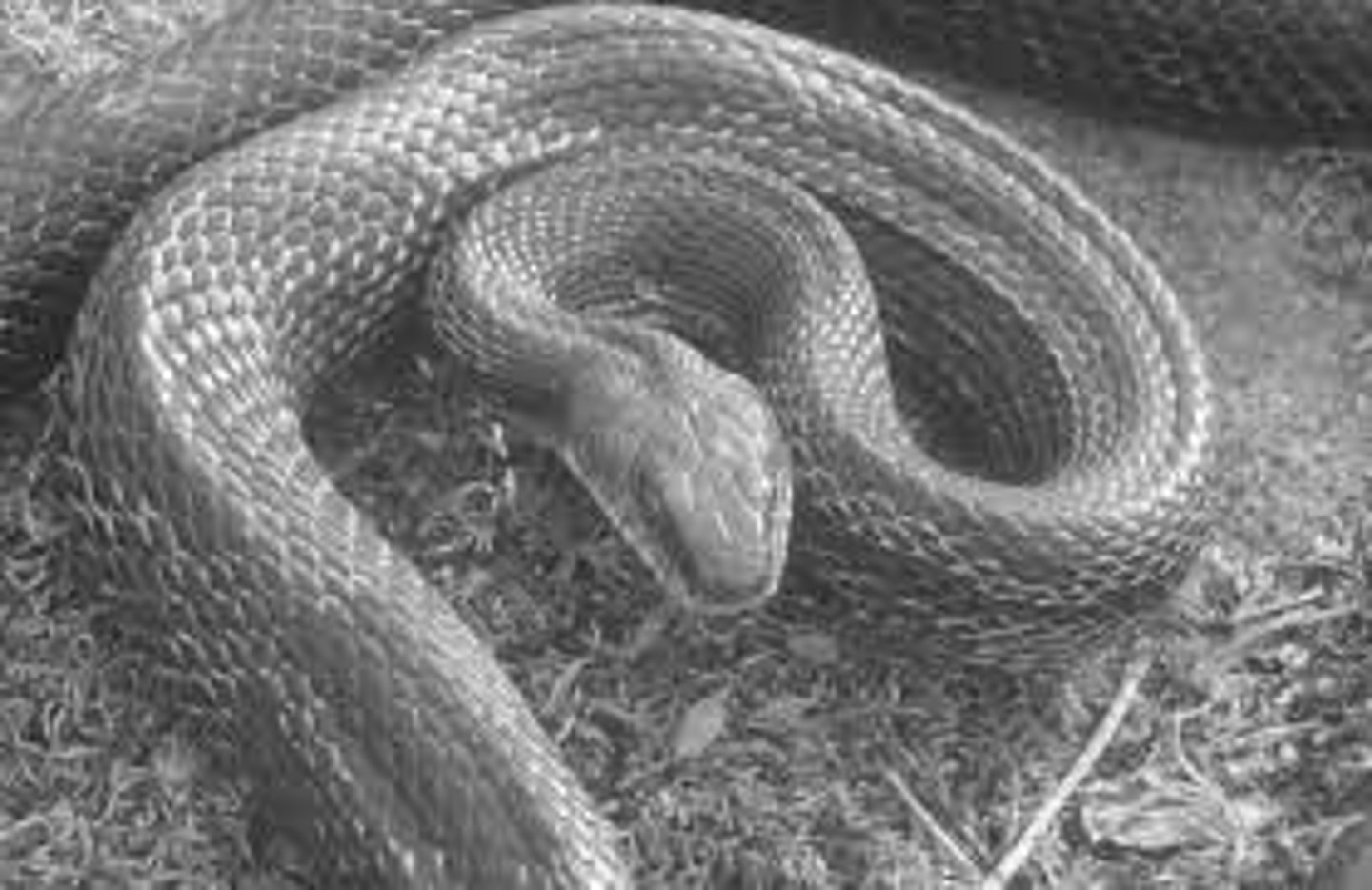
** Snakes were able to maintain their preferred body temperature regardless of variation in operative environmental temperatures. (Blouin Demers and Weatherhead)
- Body temperature is quite stable (follows pattern)
How? --Moving among different microclimates
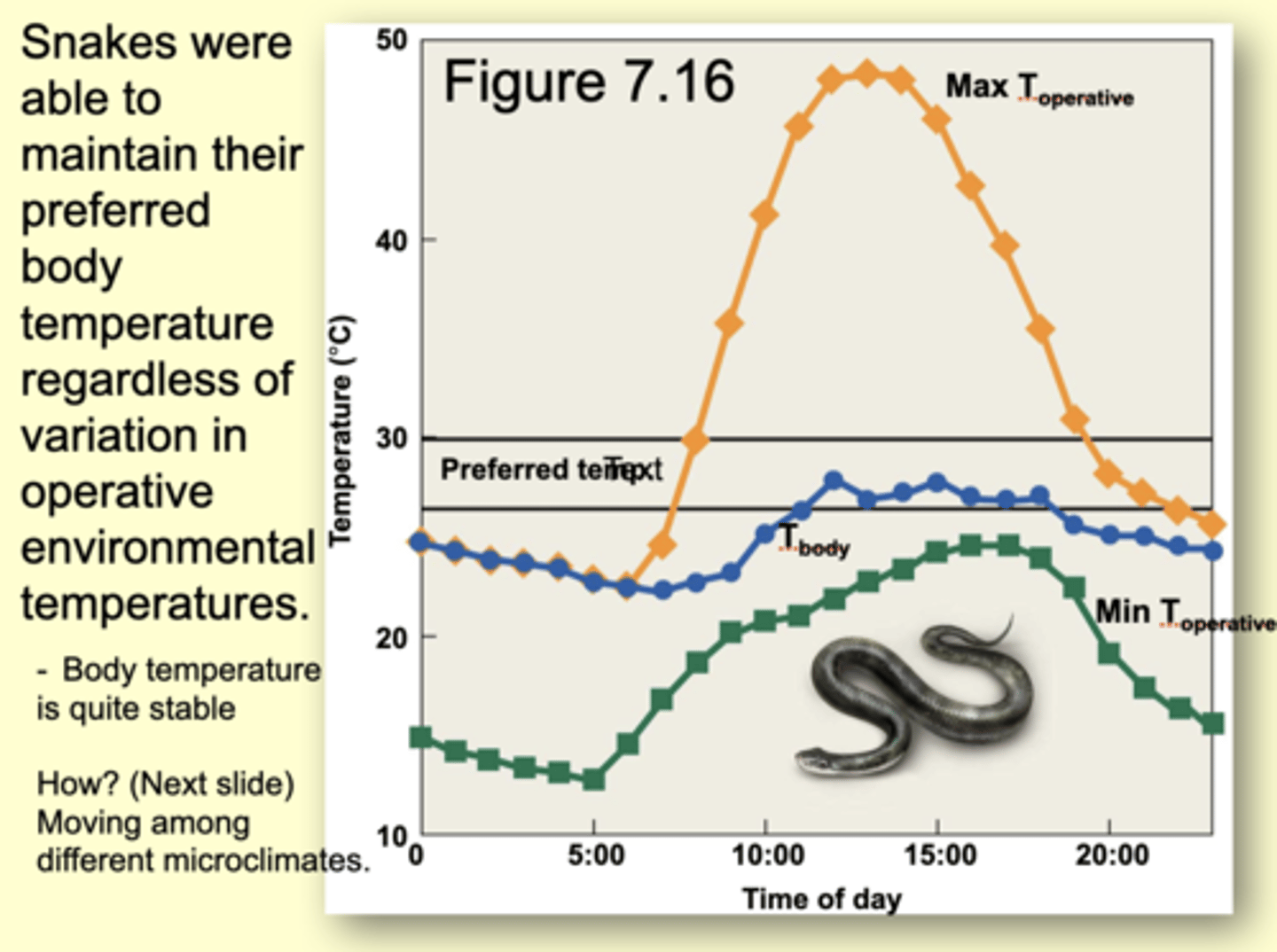
What other important traits can tradeoff with behavioral thermoregulation?
- Predation risk
- Energy balance
- Reproduction
----
"-Moving among different microclimates"-- Temperature of microclimates at given point in time during the day.
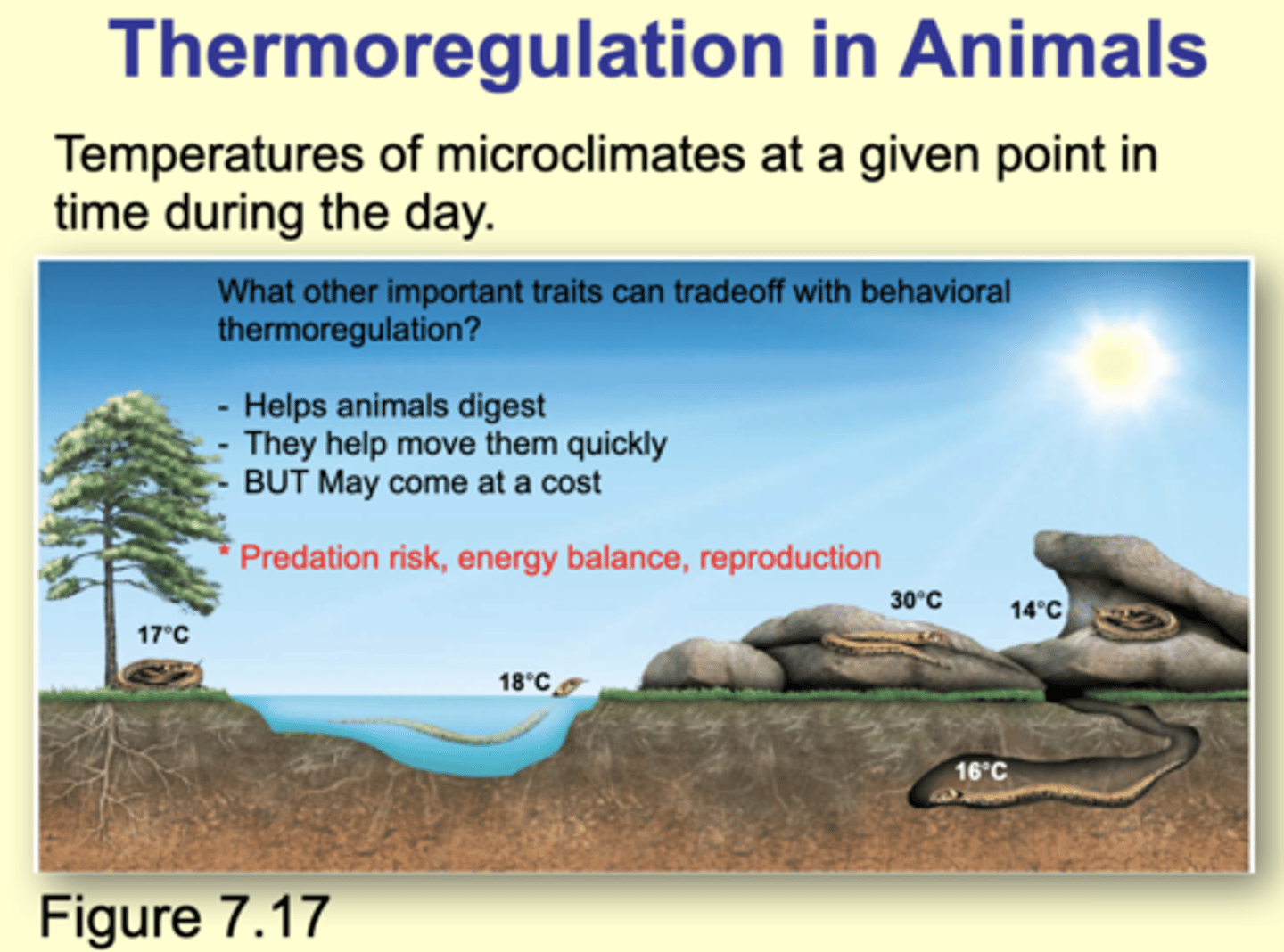
In addition to finer scale temporal decisions (fig 7.19--moving among different microclimates) , poikilotherms can also adjust over larger time periods.
Can undergo temperature acclimation
* allows a shift in the relationship between body temperature and performance
* usually involves biochemical changes, such as shifts in enzyme systems
- Different isozymes, each with different functionalities at a given temperature
- Different amounts of (same) enzyme produced
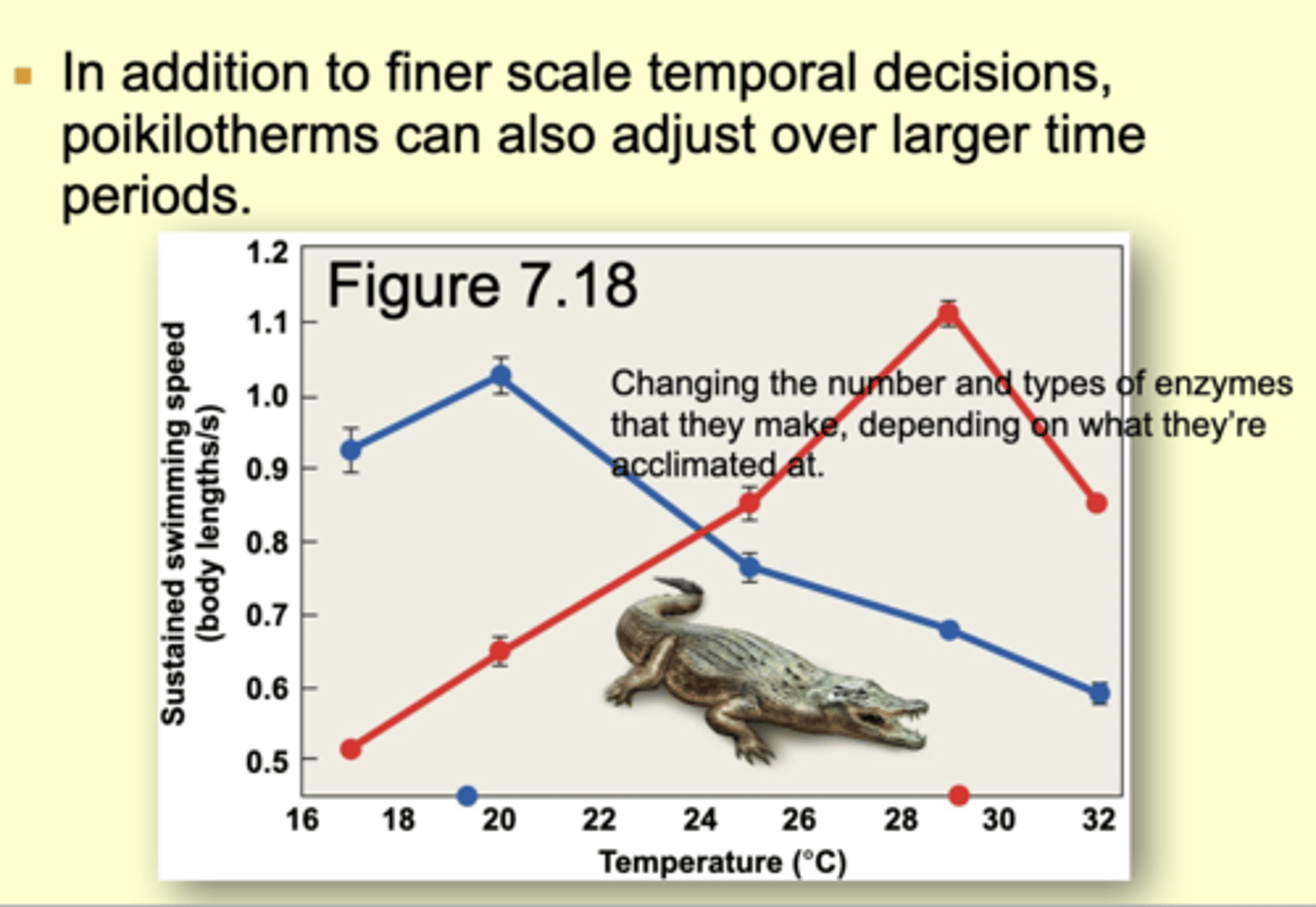
Thermal conductivity of water
is about 25x greater than that of air.
---
- Animals in aquatic environments reach a temperature equilibrium with the water much faster than terrestrial organisms do with air
- It is much more difficult for aquatic organisms to have a body temperature much different than the water temp.
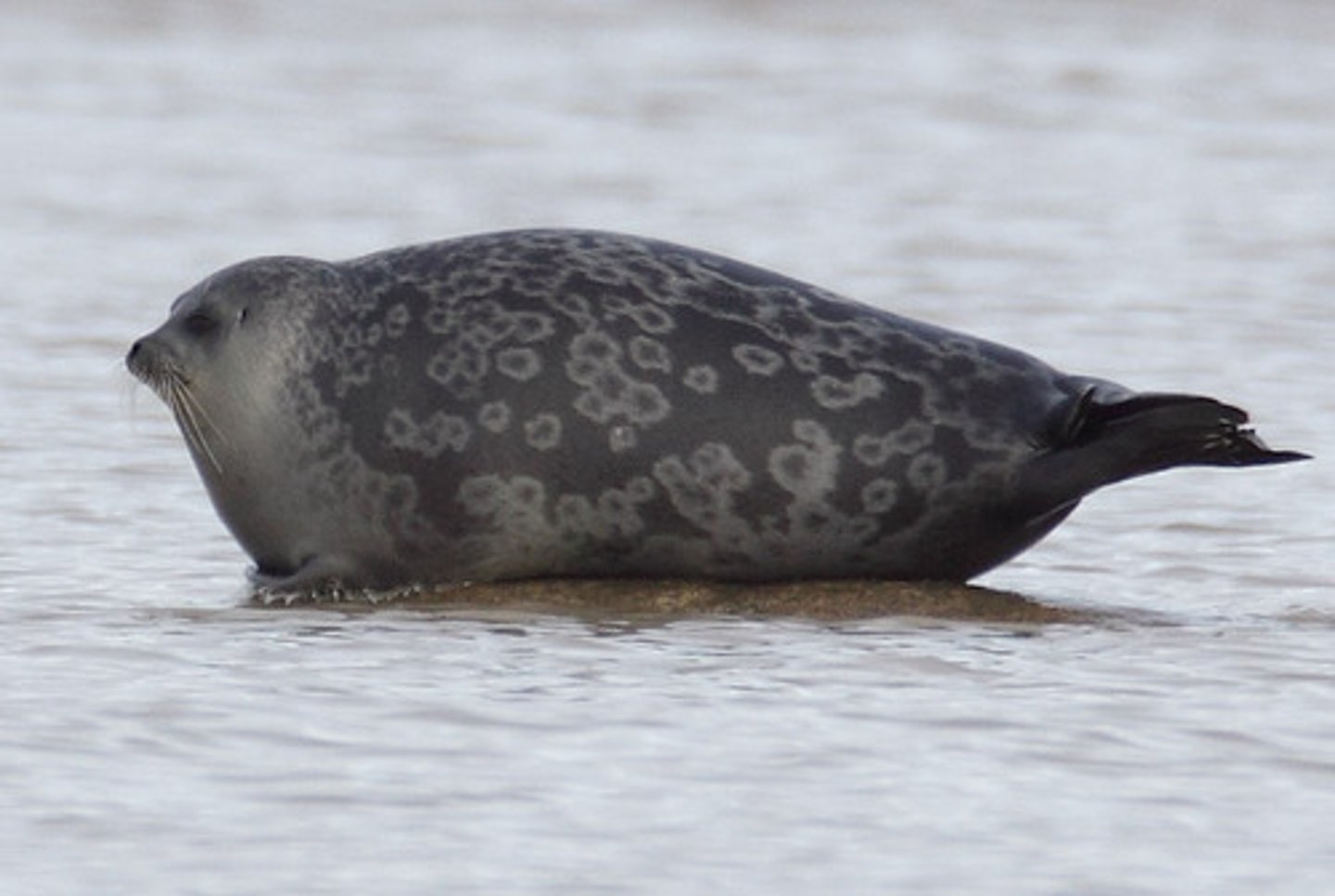
Aquatic poikilotherms are poorly insulated.
Heat produced in muscles moves to blood, then the gills and skin , then is transferred into the water by convection.
-----
- Some sharks and tunas use a counter-current exchange system to retain some body heat.
Seasonal water temperatures are relatively stable (Aquatic poikilotherms)
- Acclimate to changes from one season to the next
- Slowly changing T(max) and T(min) as the water temperature slowly changes; fish are sensitive to rapid changes.
Birds and mammals produce heat through
Aerobic cellular respiration
-This process is not 100% efficient
- Energy is lost as heat
** What is different about the liver cells in mouse vs those in lizards ?
- more mitochondria
- "leaker" inner mitochondrial membranes
Basal Metabolic Rate
measured by the rate of oxygen consumption
- Rate of respiration is proportional to body mass - grams body mass^0.75
- Exponent varies across taxonomic groups
* Range is 0.6-0.9
* If exponent is 1 , a doubling in body mass would equate to a doubling in metabolic rate.
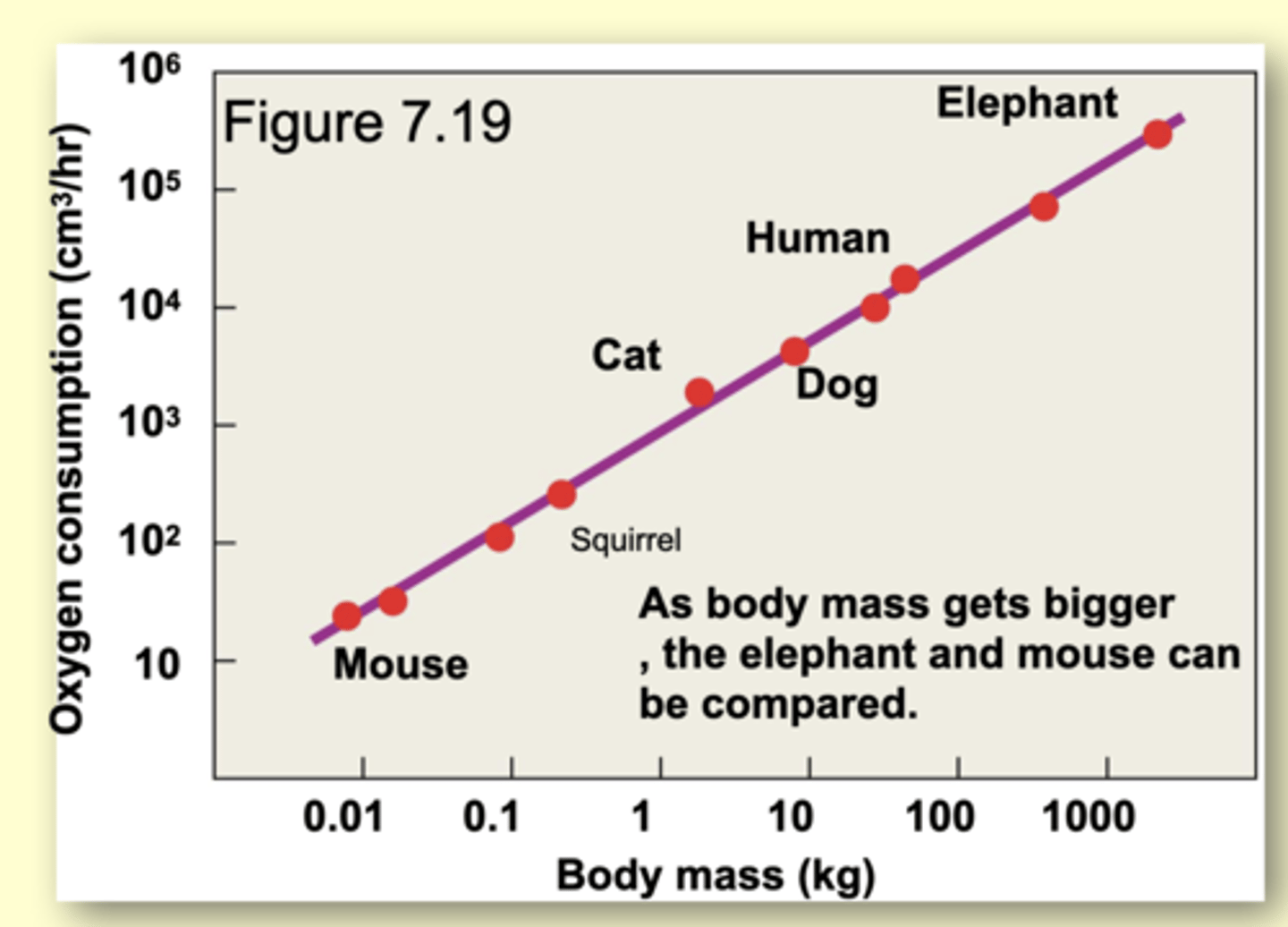
Thermoneutral zone
Range of environmental temperatures within which the metabolic rates of homeotherms is minimal
- Outside of this zone, past the critical high and low temperatures, metabolic rate increases.
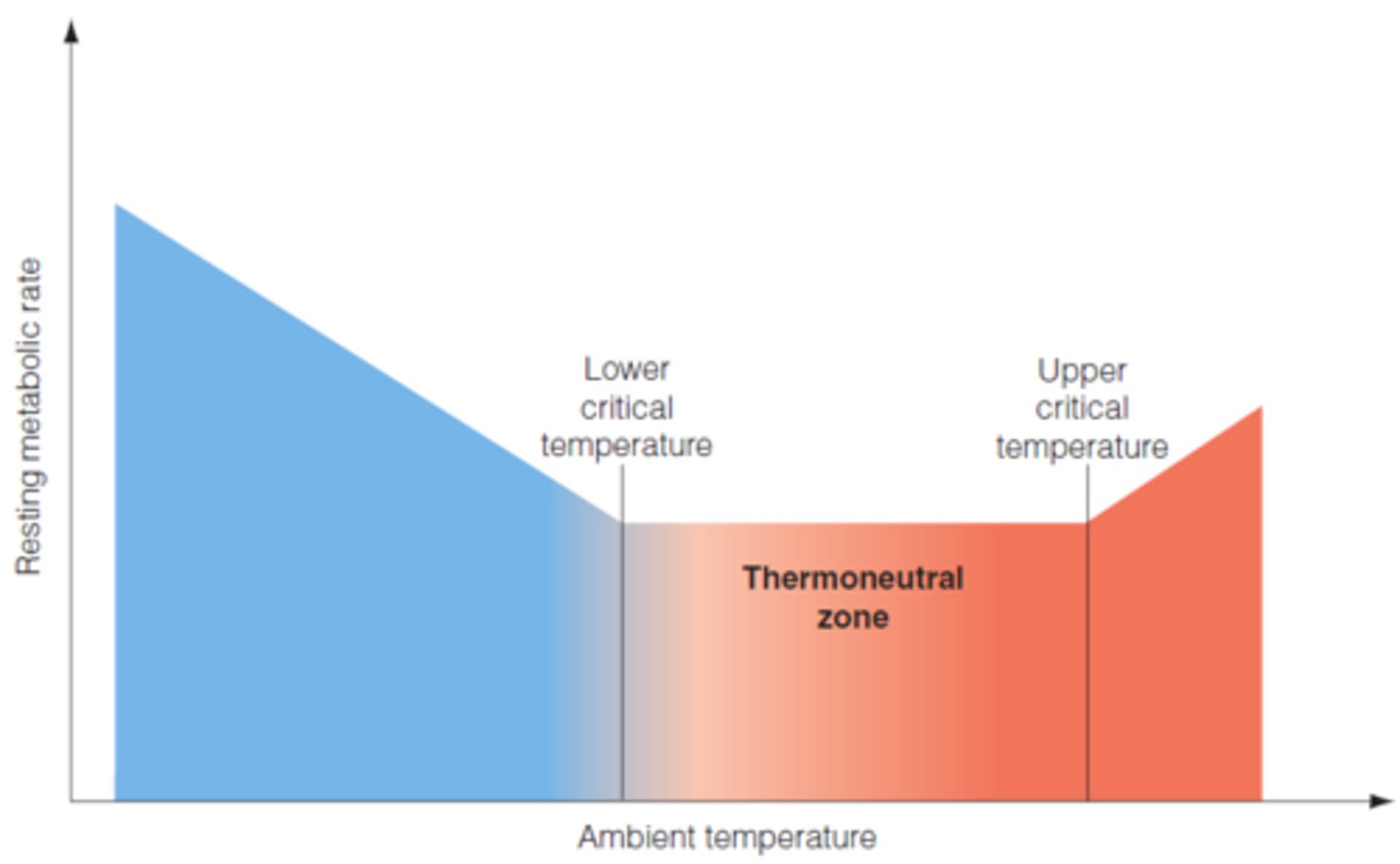
Fur-- in mammals
Insulation value varies with thickness
- fur thickness can change with season (accumulation)
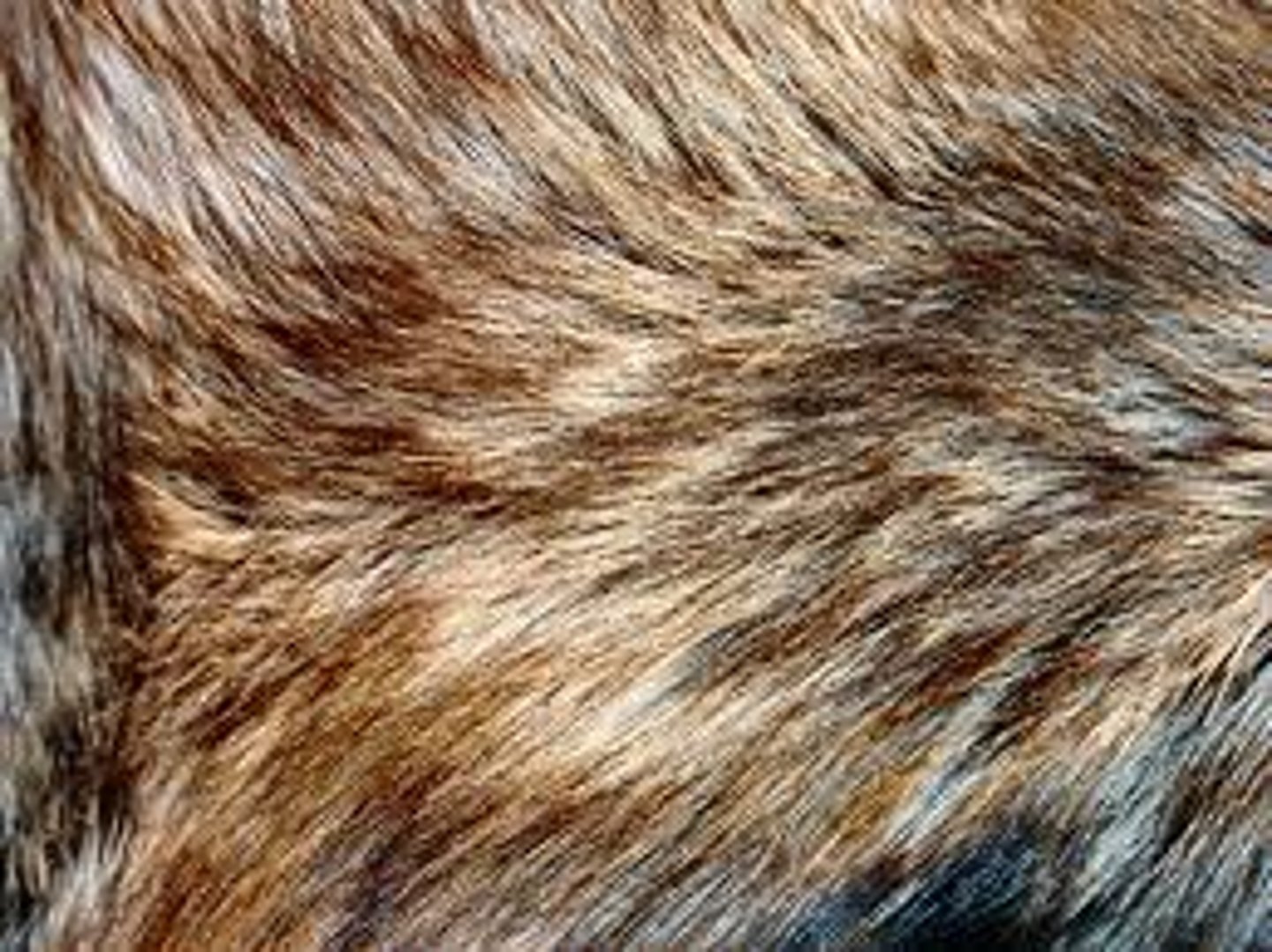
Aquatic mammals often have no hair
instead they have a layer of fat beneath the skin
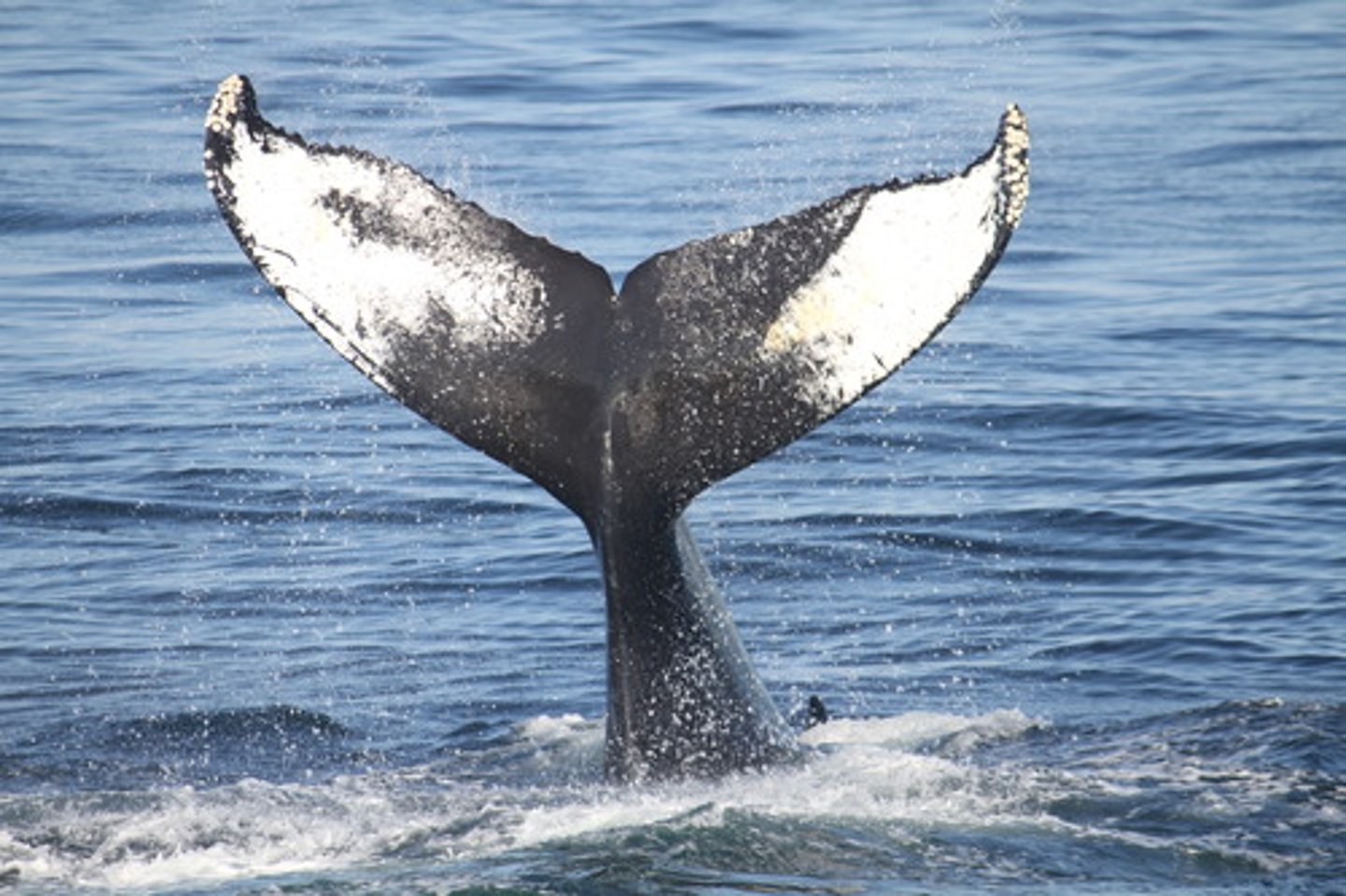
Feathers -- birds
Heat loss is reduced when the feather are fluffed

Arctic and Antarctic birds
have a layer of fat beneath the skin
(similar to aquatic mammals)
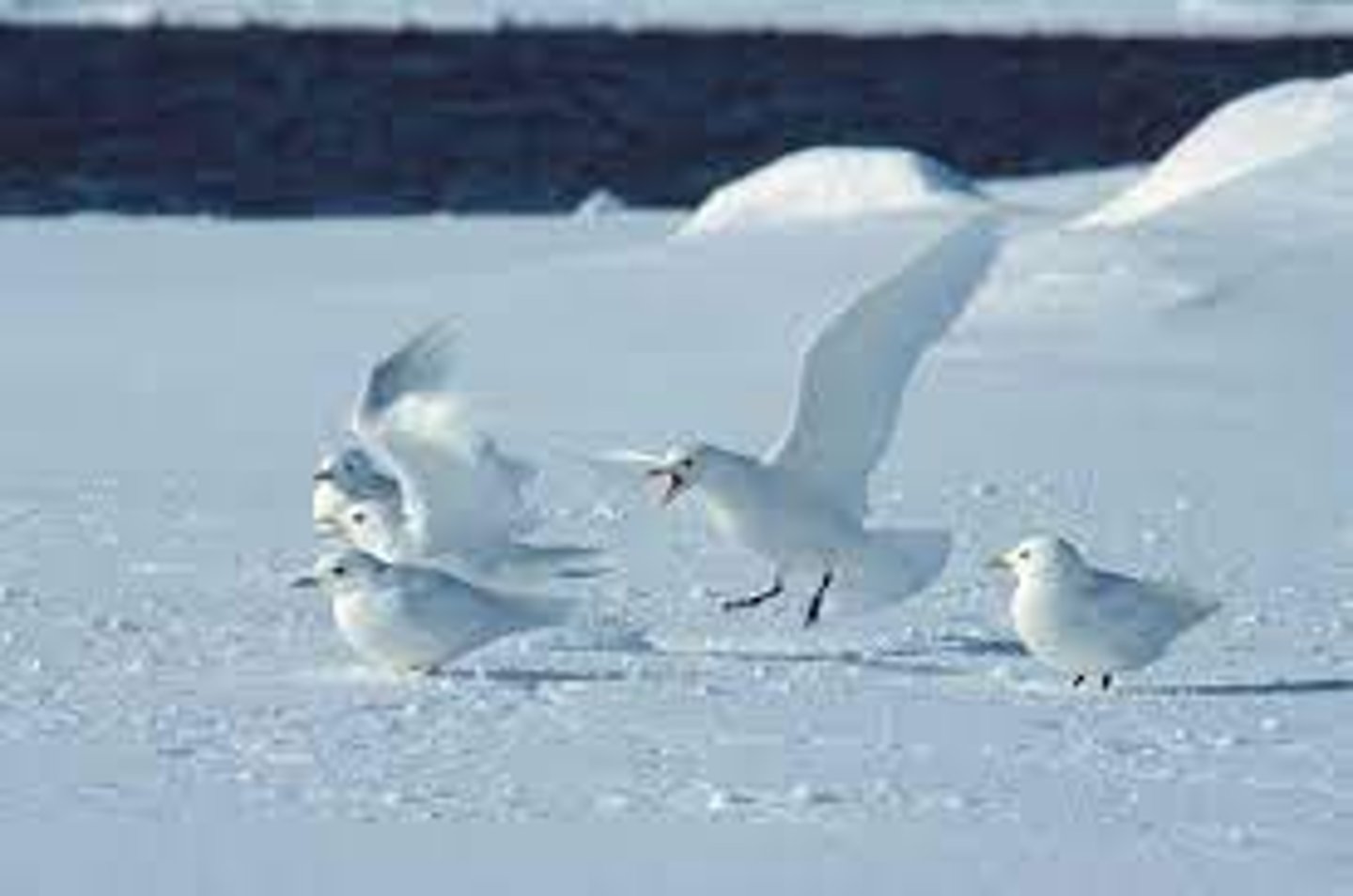
Insulation can also...
keep heat out of the body.
Animals from hot environments must
- Rid themselves of excess body heat
---------
- Prevent heat from being absorbed to begin with.
*Light body color reflects solar radiation
* Heat will not penetrate heavy fur
Ex. Camels- Outer layers of hair absorb heat and returns it to the environment.
**Some insects have a fur-like coat on the thoracic region--
retains high temperature for flight muscles
Homeotherms can raise body temperature by--
Shivering:
Brown fat:
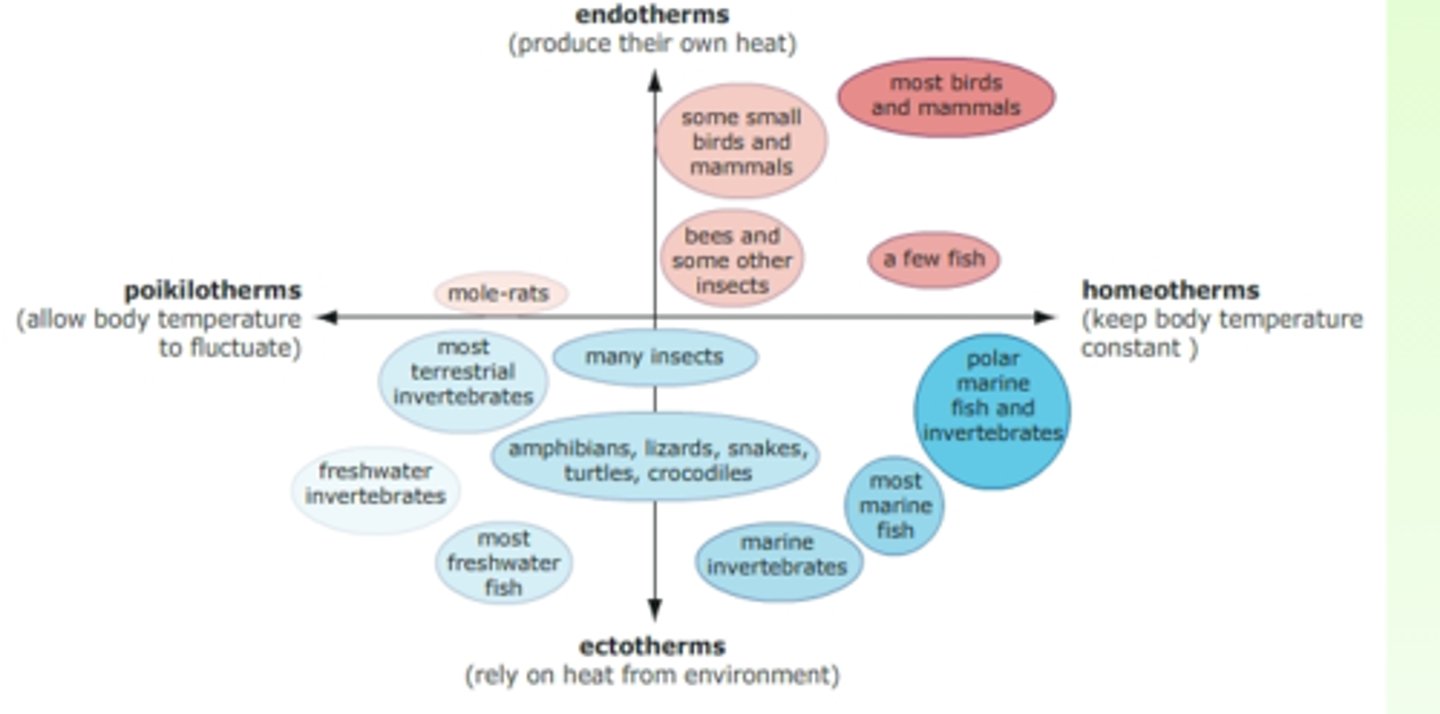
Shivering: (Homeotherms raise body temperature)
involuntary muscle action that increases heat production.
Brown fat: (Homeotherms raise body temperature)
some small mammals burn brown fat, which has many more mitochondria and generates more heat.
- found in hibernators and babies
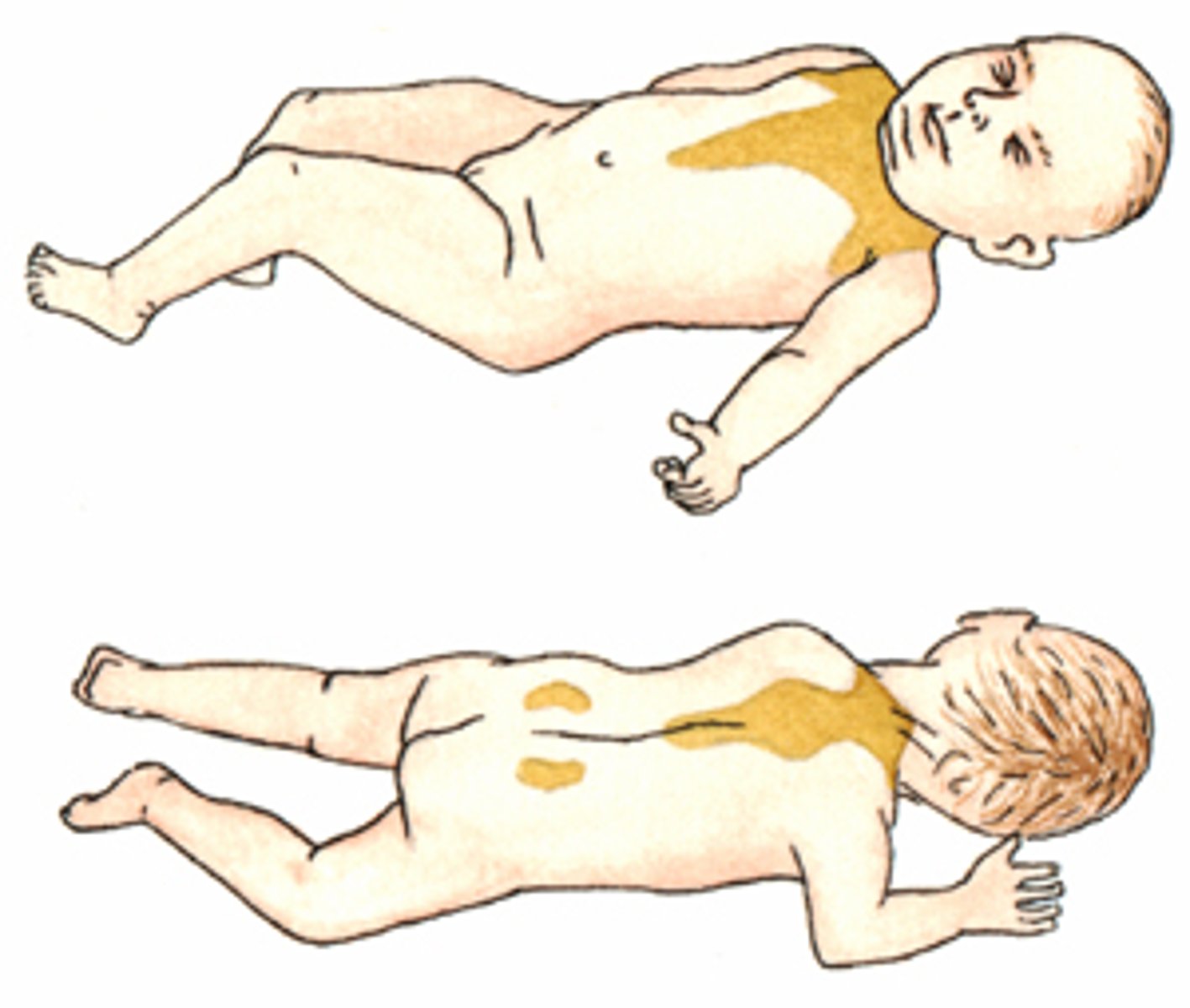
Homeotherms can lower body temperature by--
Evaporative cooling
-----
Moisture evaporated from the skin and heat is lost
- Panting and sweating accelerate evaporative cooling
- Birds use gular fluttering; cloacal cooling (reptiles, birds)
- Some animals wallow in water or wet mud.
Endothermy vs. Ectothermy
Are two alternative approaches to body temperature regulation in animals
----
endo heat from within
ecto heat from the environment
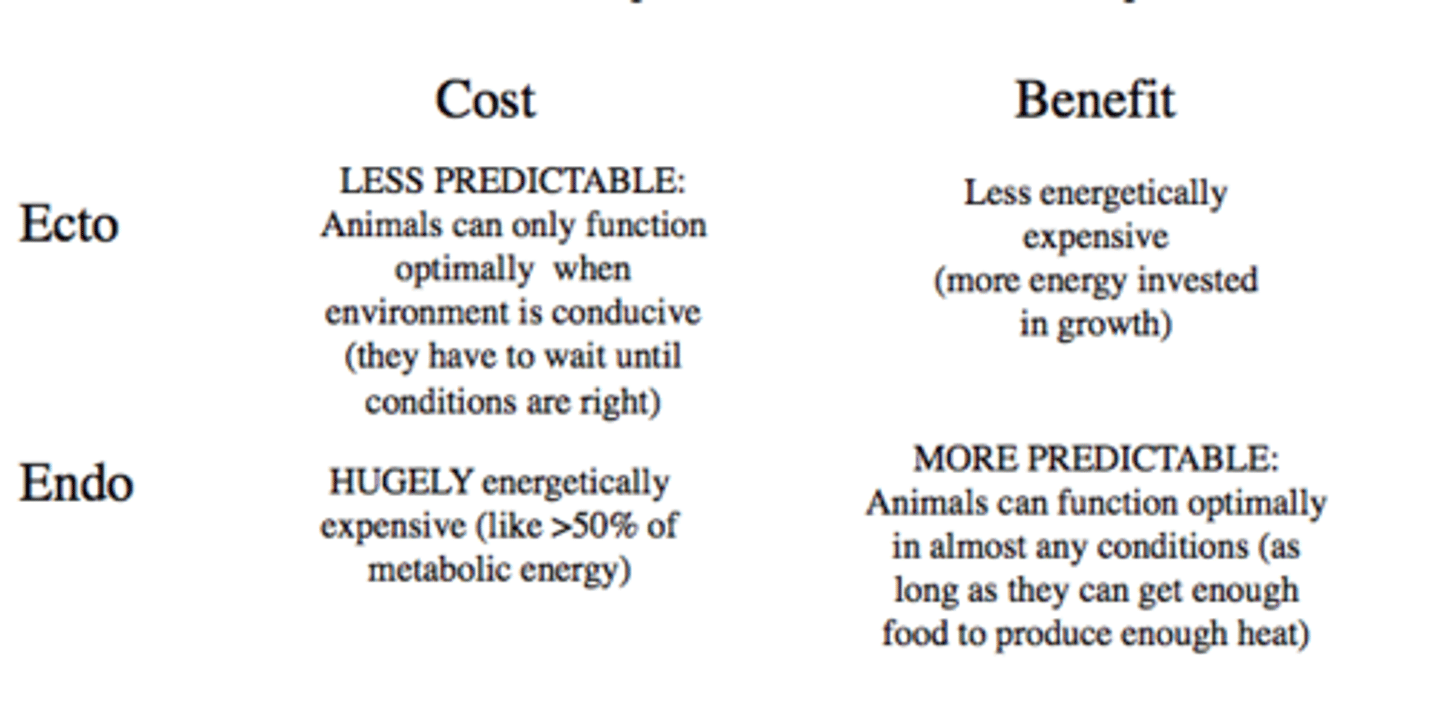
Ectothermy benefits
- Lower metabolic rate requires fewer calories per gram of body weight (less food)
- Can allocate more energy to producing biomass than to metabolism
- Can reduce or curtail metabolic activity when food or water is limited, or environmental conditions are extreme
- Can live in environments where food and water are limited
Ectothermy costs
- Temperature of the environment determines activity
- Maximum body size is constrained because heat is absorbed across the body surface
*Surface/volume ratio becomes to low for heat to warm the entire body mass
* Larger ectotherms can live in only in warmer environments
Endothermy benefits
- Homeotherms can remain active even if environmental temperature varies
- Maximum body size is not constrained because heat is generated internally
- Large endotherms can live in cool environments
Endothermy costs
- Higher metabolic rate requires more calories per gram of body weight (more food)
- Small endotherms must eat almost constantly
(why?--because they loss so much heat through their large relative surface area)
- Usually allocate more energy to metabolism than to producing biomass
- Producing insulation
One cost of endothermy is "Usually allocate more energy to metabolism than to producing biomass" -- How does this affect the growth of young endotherms?
Young endotherms are often born in altricial state:
- Blind, naked, helpless, ectotherms
*Depend on parents to maintain body temperature
- allow them to allocate more energy to growth early in life.
Given the costs of endothermy, why might it have evolved independently in several taxonomic groups?
1) Linked to the selection for high levels of activity sustained by aerobic metabolism
*Improved foraging, defense, home range size, etc
*If maximal MR goes up, so does resting MR
-------
1. Linked to parental care
*Embryos particularly sensitive to temperature
* Early endothermy relegated to parental period only…but this expanded to non-parental periods over time/
Heterotherms
have characteristics of both ectotherms and endotherms
------
can tolerate changes in body temperature
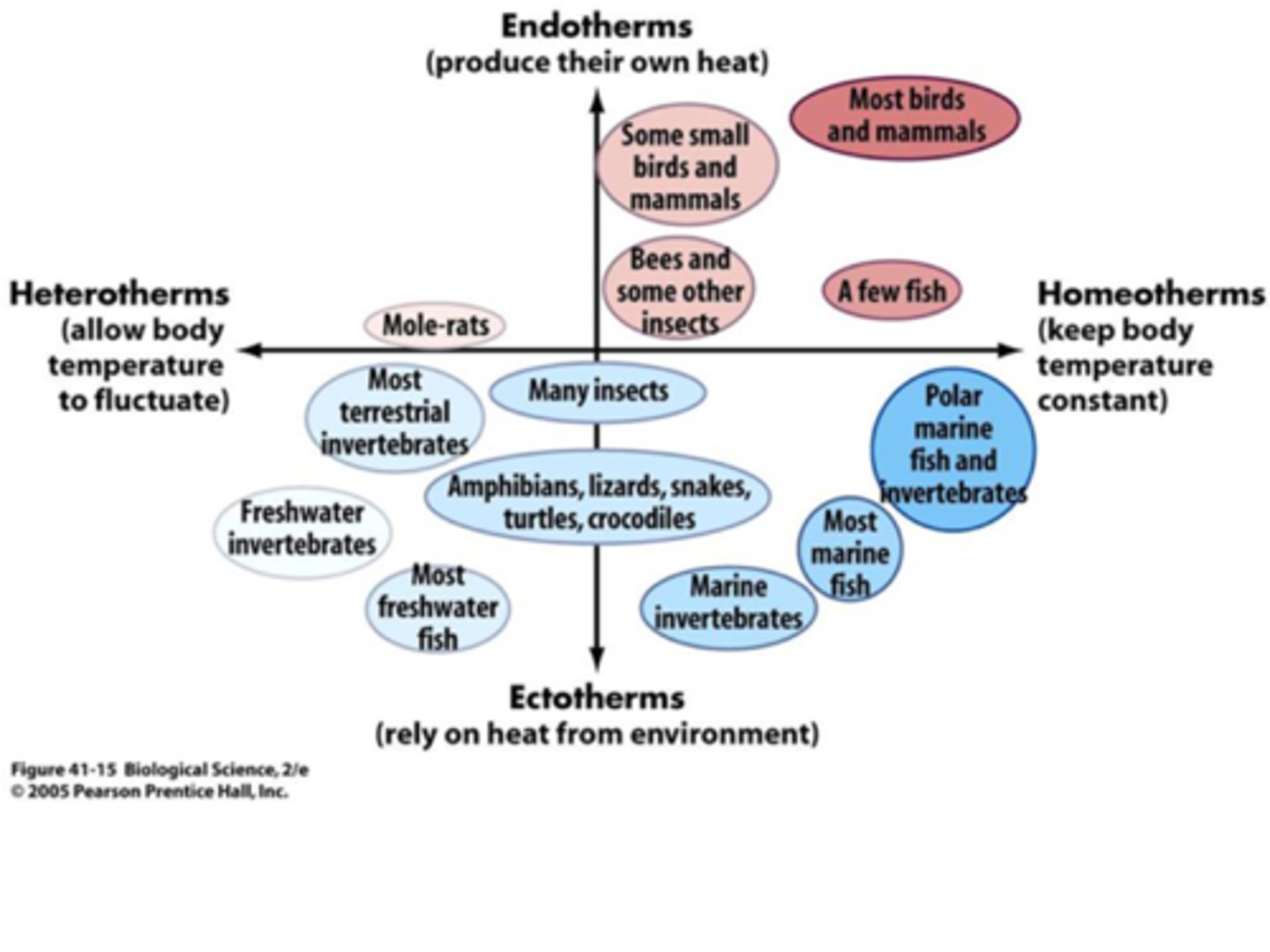
Temporal heterotherms
have characteristics of endotherms at some times and characteristics of ectotherms at other
- times may be daily or seasonally or only in certain situations
Adults of most flying species are....
Although insects are generally ectothermic poikilotherms. - (Variable temp thats derived exclusively from their external environments.)
------
Adults of most flying species are heterotherms
- Have a high metabolic rate when flying
- Insects flight muscles function between 30*C and 44*C.
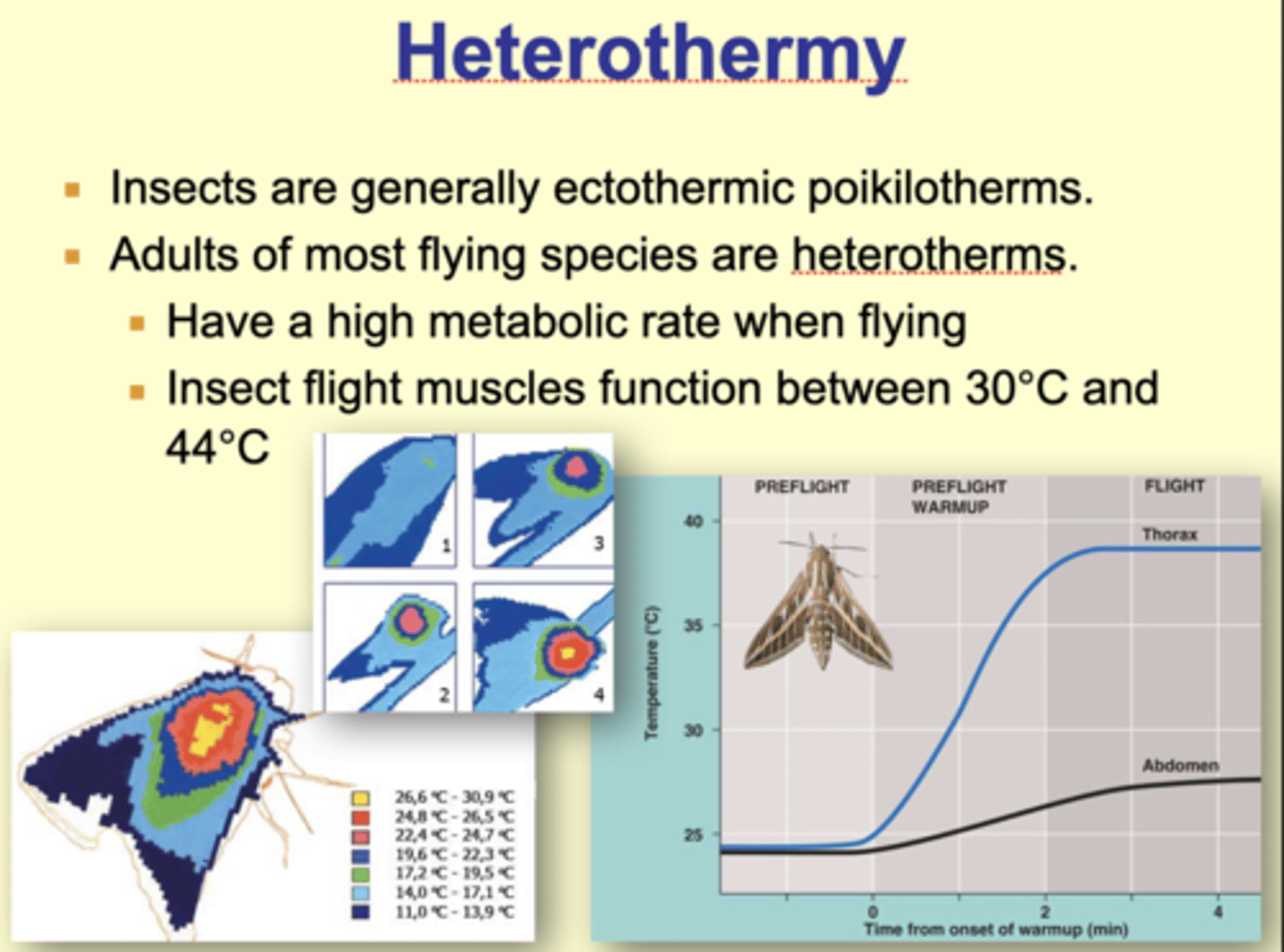
"Although insects are generally..."
"ectothermic poikilotherms. - (Variable temp thats derived exclusively from their external environments.)"
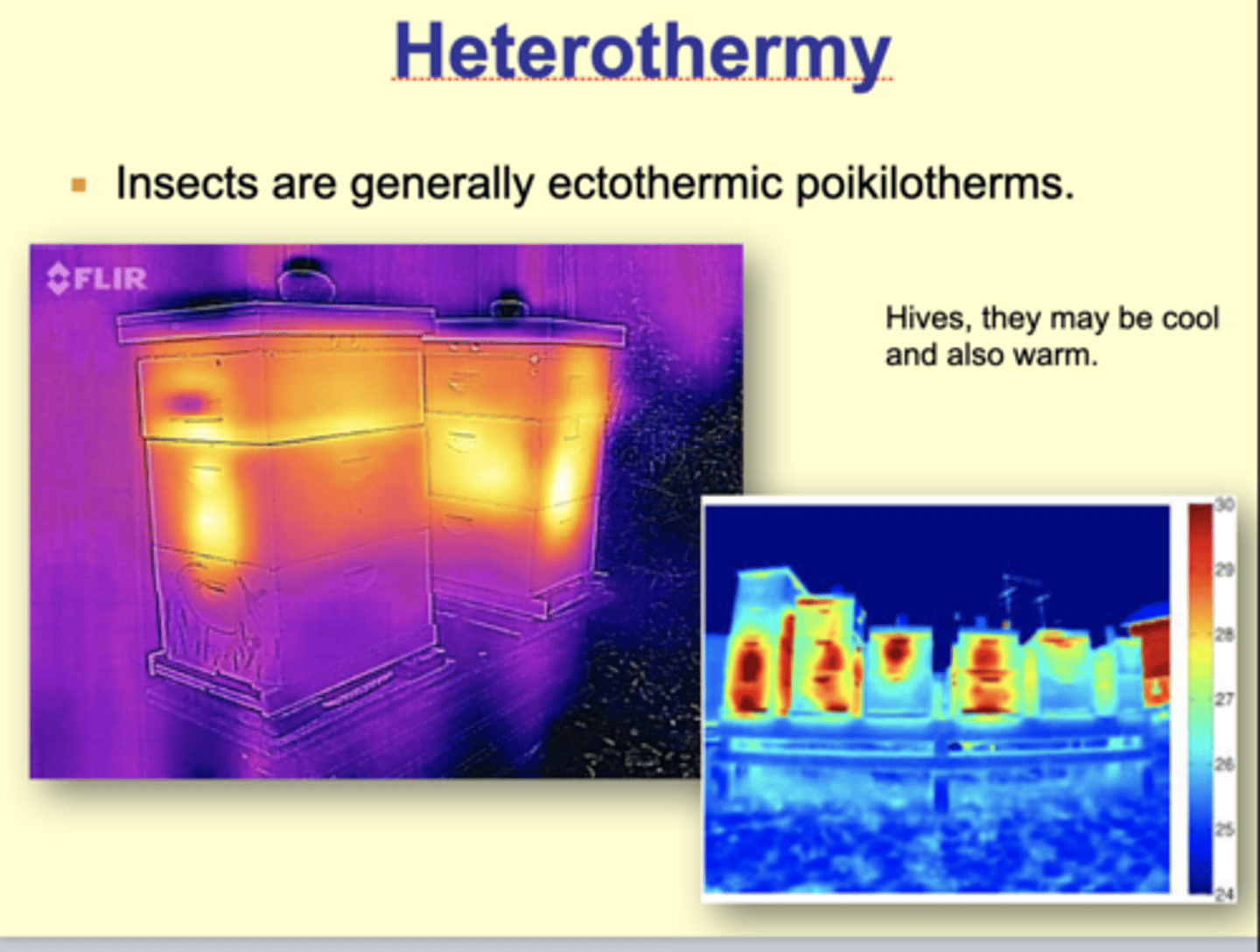
**Insects flight muscles function between 30*C and 44*C.(Adults of most flying species are. heterotherms)
Shiver their flight muscles, vibrate their wings, and/or orient their bodies to the sun and spread their wings
---
Once in flight, wings beat up to 200 times per second, producing large amounts of heat
There is no physiological set point
When not flying, they cool to ambient temperatures
Small homeothermic animals become...
heterothermic to reduce metabolic costs when they are inactive.
Referring to Torpor
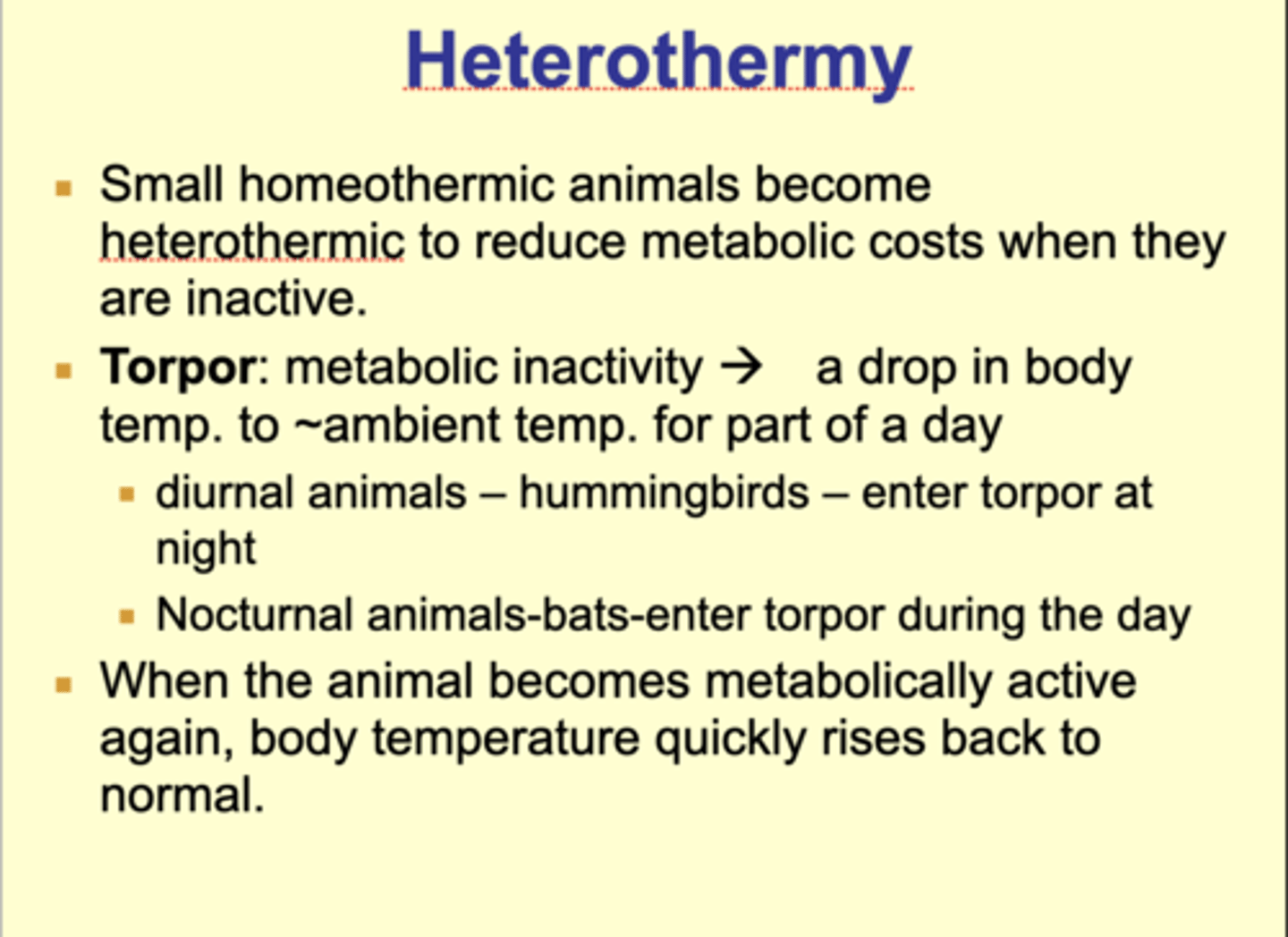
Torpor
metabolic inactivity => a drop in body temp. to (~) ambient temp. for part of a day
----
Diurnal animals = humming birds - enter torpor at night
Nocturnal animals = bats- enter torpor during the day.
----
*When the animal becomes metabolically active again, body temperature quickly rises back to normal.
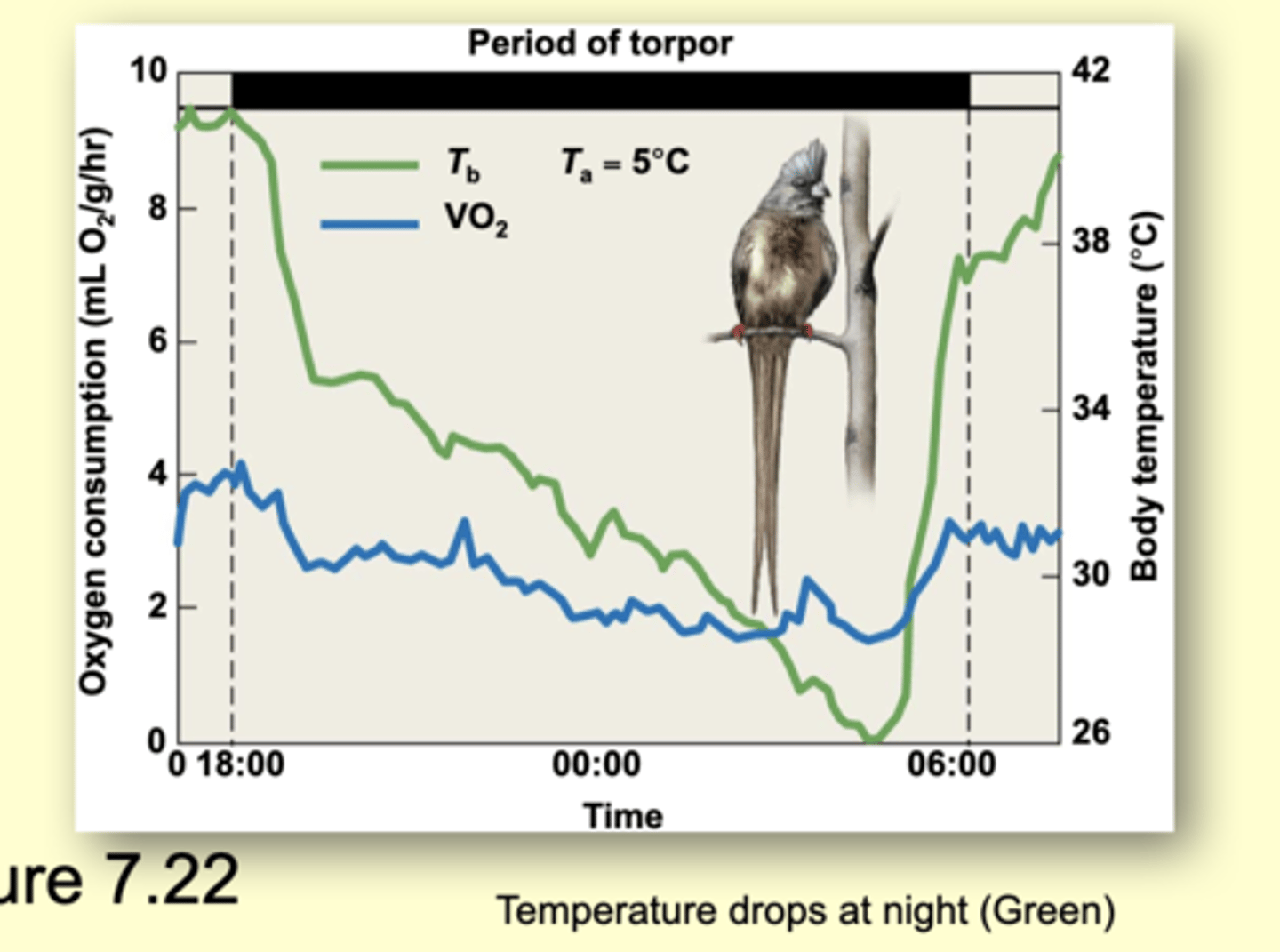
Hibernation
the dropping of the body temperature to near ambient temperature for a long period of time during the winter
- A state of controlled hypothermia:
- Animals rewarm using only metabolic heat
--------
(Long-term torpor that is an adaptation to winter cold and food scarcity.)
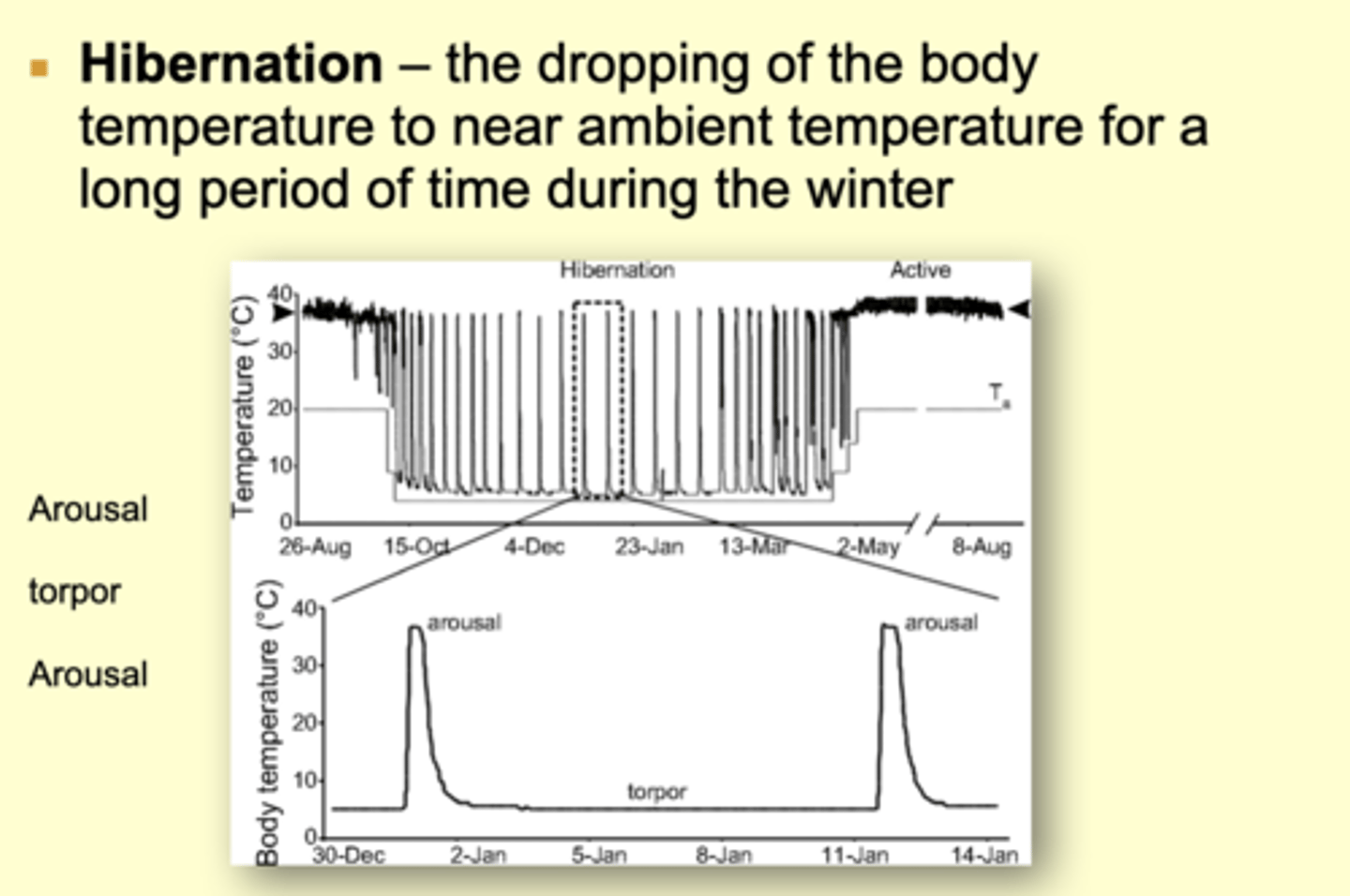
**A state of controlled hypothermia: (Hibernation)
- Heart rate, respiration, total metabolism drop
- Body temp goes below 10°C
- Animal goes into acidosis
- CO2 levels in blood increase, blood pH decreases (drops shivering threshold)
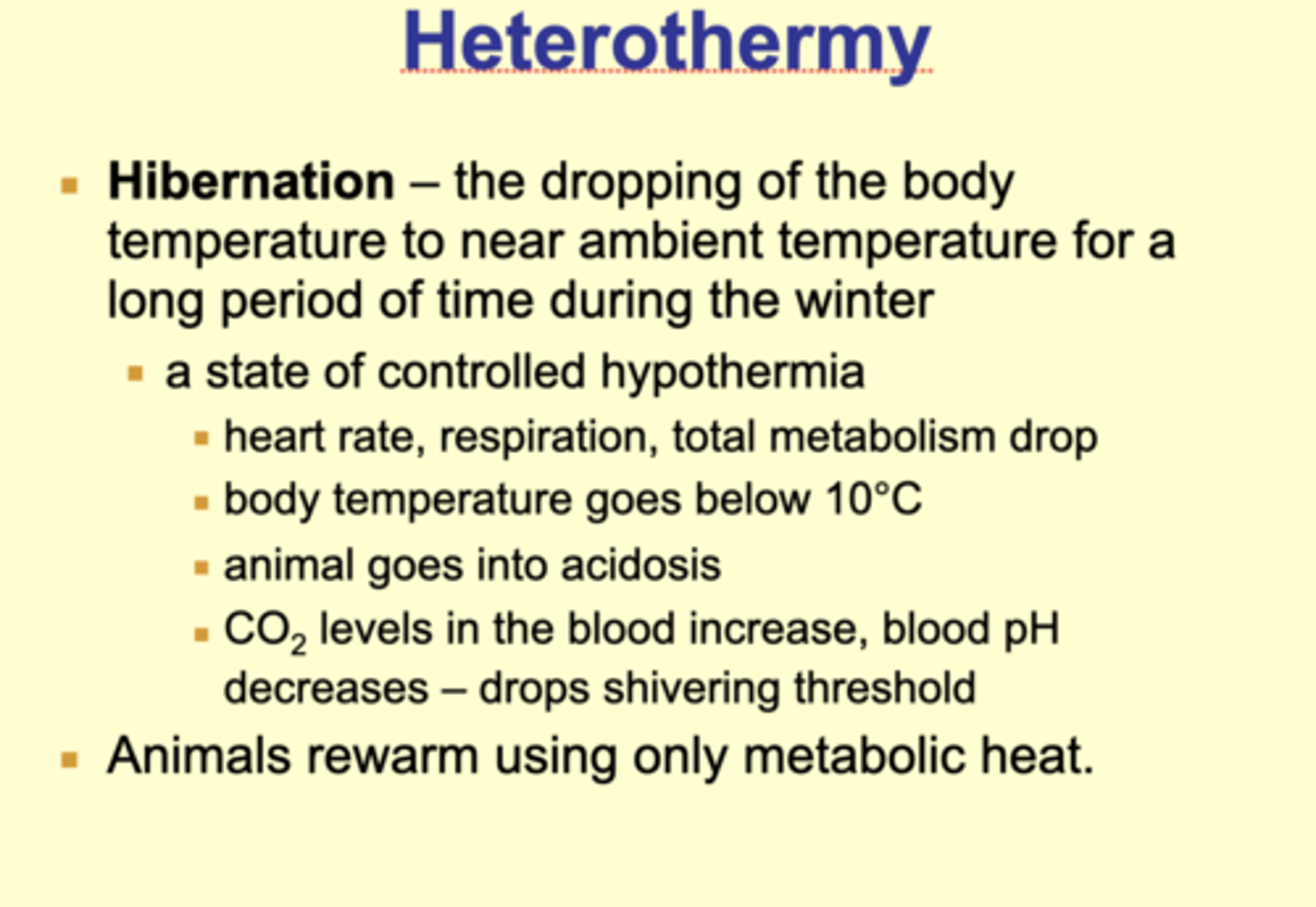
**Animals in hot dry climates face a challenge-(Heat is dissipated at night.)
– losing heat without losing too much water through evaporative cooling.
-----
- Animals from these regions, such as the camel and oryx, store body heat during the day
Ex: a camel’s temperature can rise from 34*C in the morning to 41*C in late afternoon
---
- Heat is dissipated at night.
- Reduces the need for evaporative cooling and so reduces water loss.
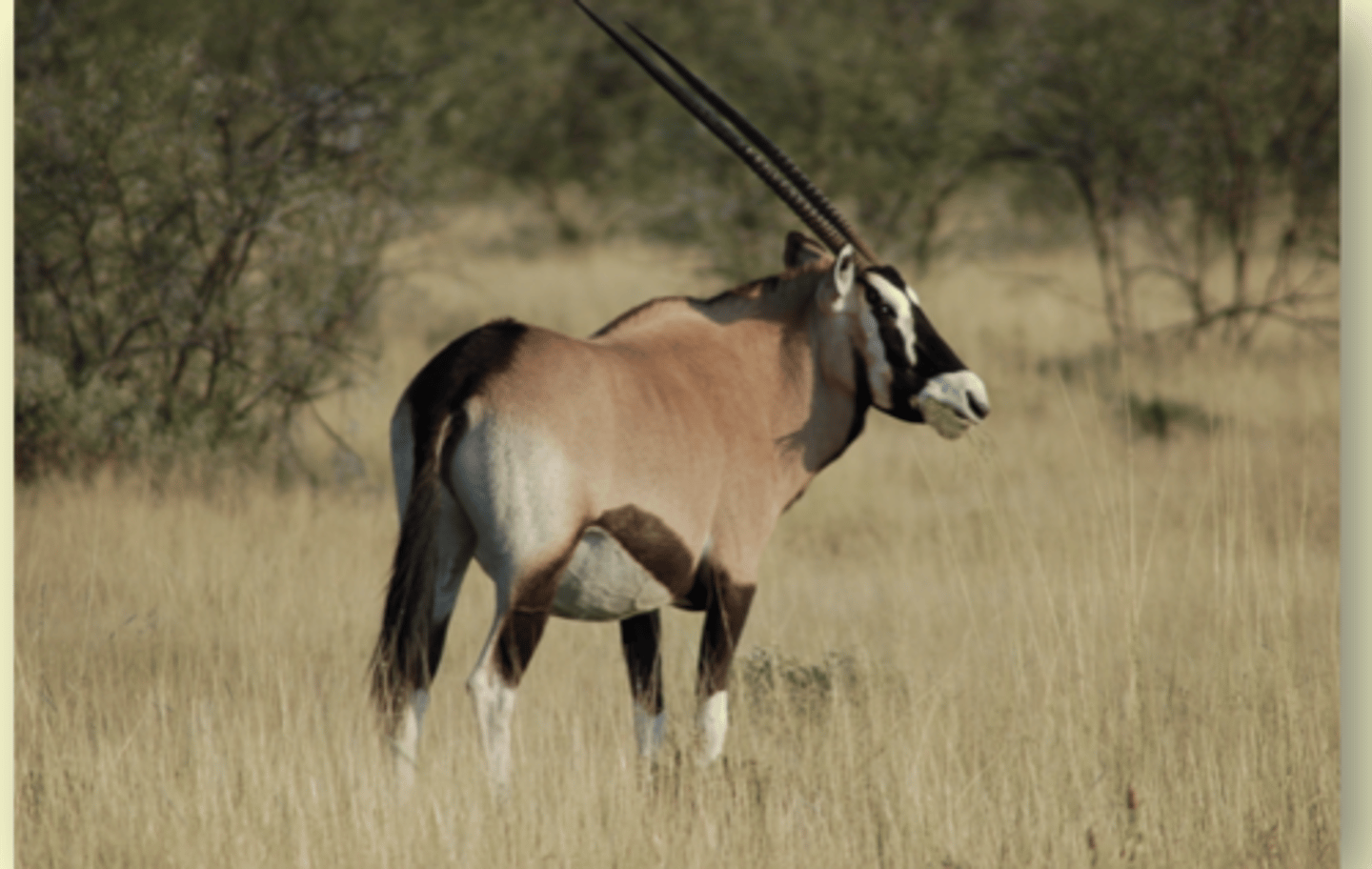
Ectotherms in cold climates endure long periods of temperatures below freezing – how do they withstand this without freezing solid?
Supercooling
Supercooling
of body fluids--the body temperature falls below the freezing point of water but does not freeze:
- solutes in blood lower the freezing point
- animals from many different groups increase the glycerol in body fluids
*Protects against freezing damage
Some aquatic vertebrates and insects do freeze, then thaw when temperatures rise
More than 90% of the body fluid freezes
- remaining fluids have a high solute concentration
- ice is present outside the shrunken cells
- muscles and organs become distorted
* After thawing, normal shape is restored
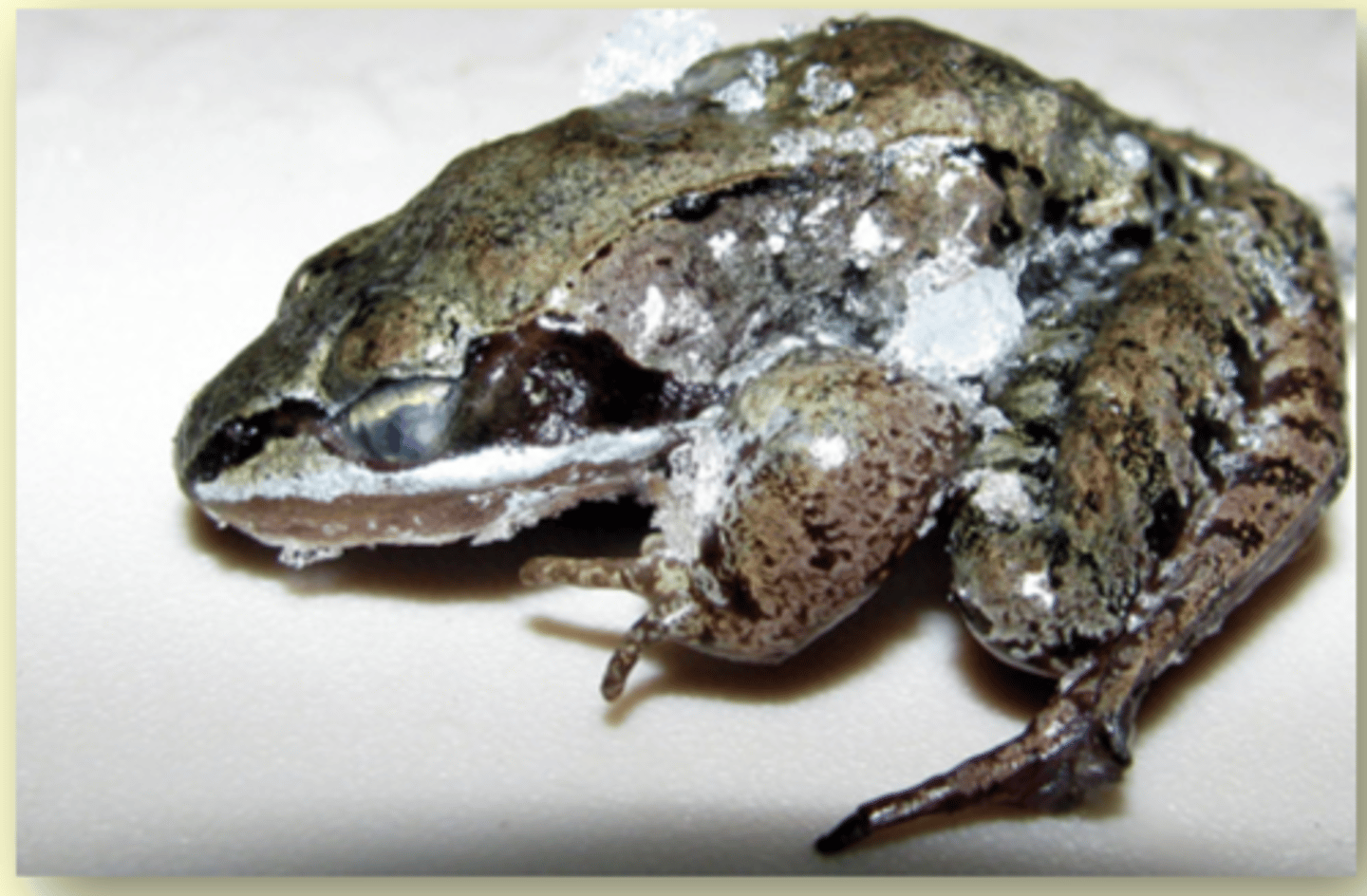
Countercurrent heat exchange system requires...
blood vessels that flow in opposite directions in close proximity.
----
**With countercurrent exchange, the close proximity of the artery and vein allows heat to be transferred from the warm arterial blood to the colder venous blood as it travels back into the body interior, conserving heat.
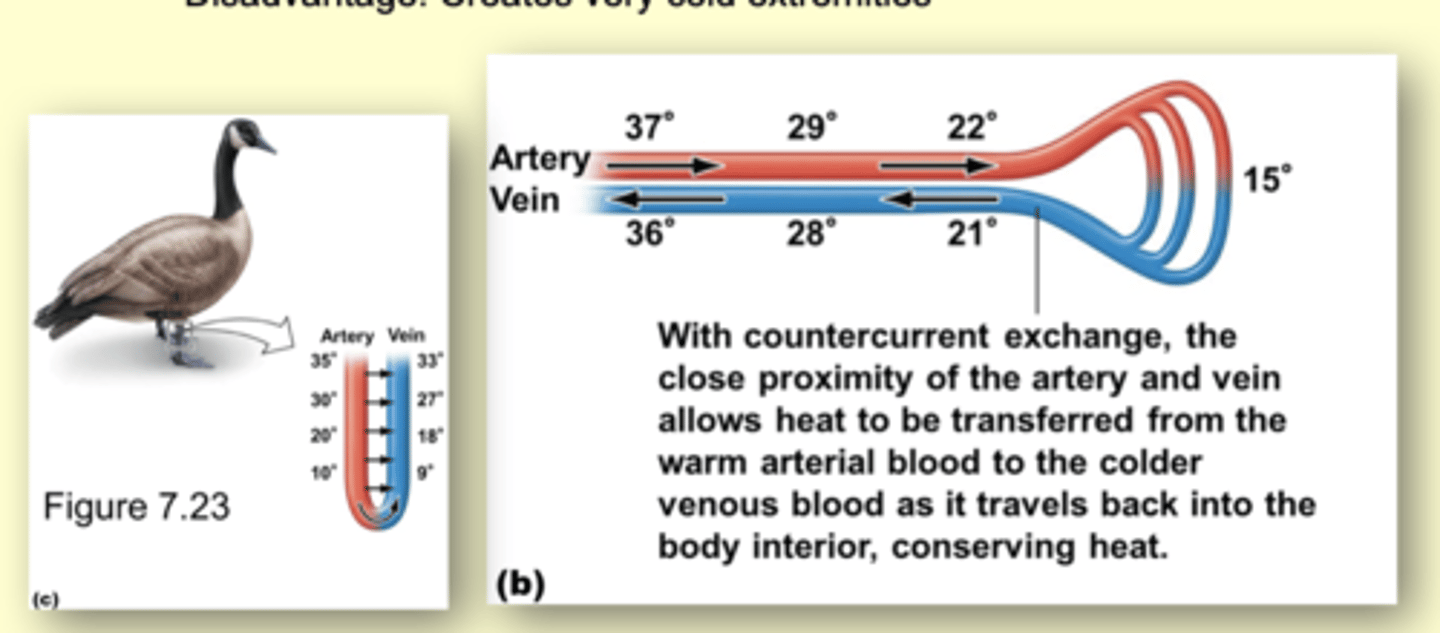
What are some advantages of countercurrent heat exchange?
Advantage: Can maintain core T(body)
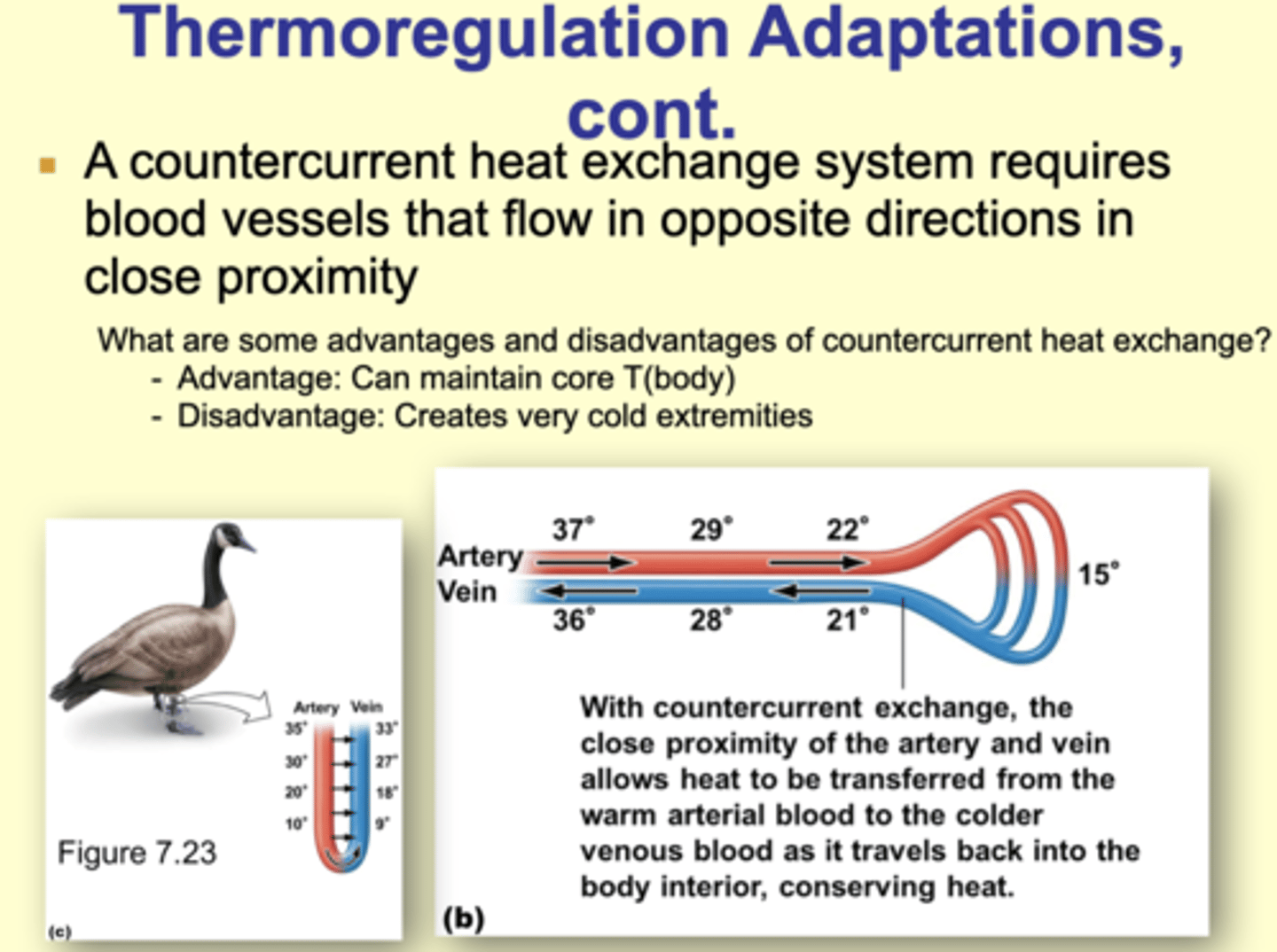
What are some disadvantages of countercurrent heat exchange?
Disadvantage: Creates very cold extremities
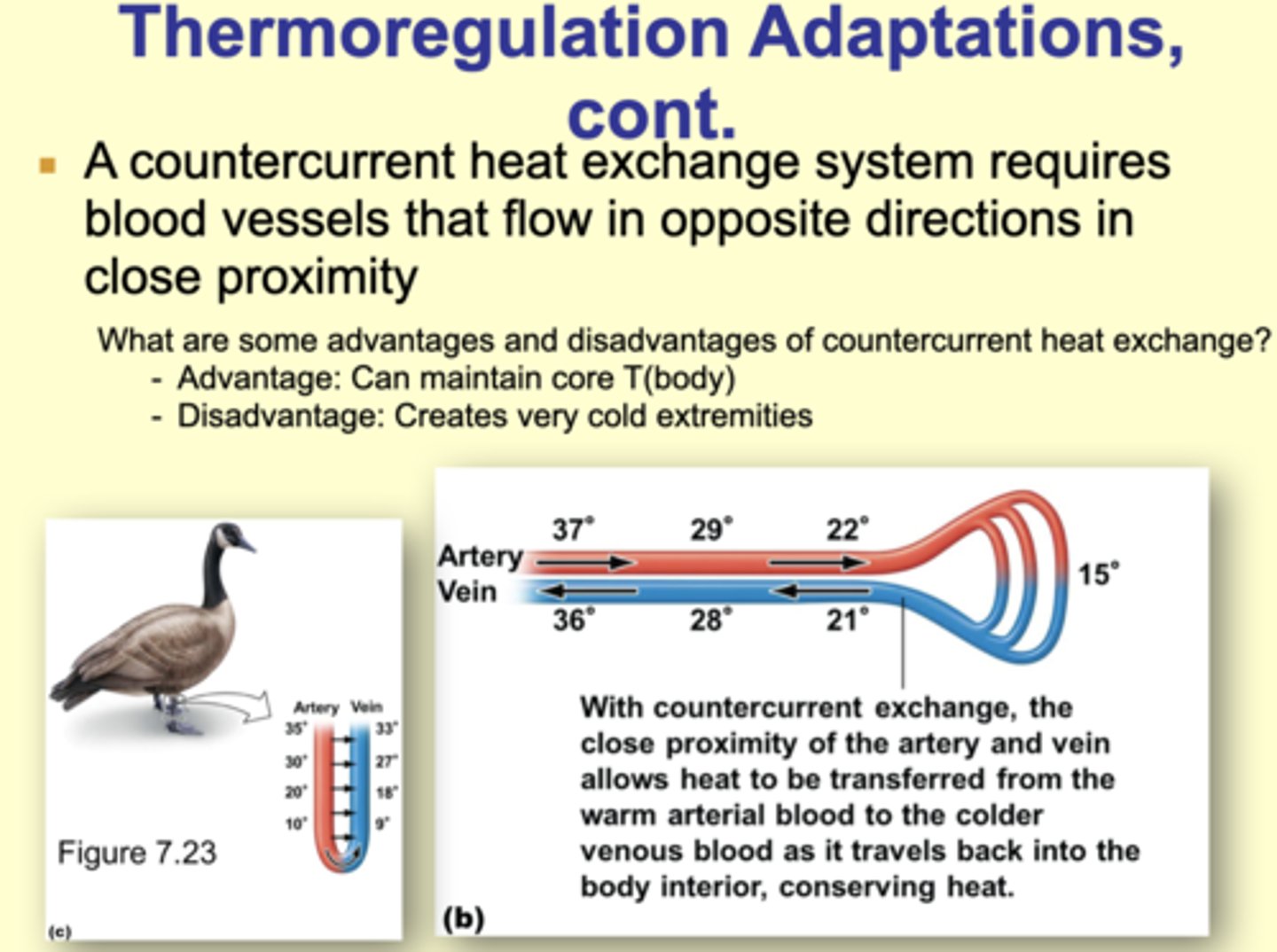
Countercurrent exchange often used in conjunction
with vasodilation/vasoconstriction.
